THREE CENTURIES OF BRITISH




17th October - 15th D ecember 2023
In association with BAGSHAWE FINE ART, LONDON
GUY PEPPIATT FINE ART, LONDON
MOORE -GWYN FINE ART, LONDON
Front cover:
John Hayter (1800-1891)
Detail from ‘Interior of a Painter’s Study –Edwin Landseer (1802-1873) at his easel’ [Cat.22]
Rear cover:
George Romney (1734-1802)
Detail from ‘Studies for ‘Viscountess Bulkeley as Hebe’’ [Cat. 9]
Opposite Page:
Dame Barbara Hepworth, D.B.E. (1903-1975)
Detail from ‘Abstract – A Table Linen Design for Porthia Prints’ [Cat. 68]
CAT. 1
Tilly Kettle (1735-1786)
Portrait of Henry Willement
Oil on Canvas
24 by 20 inches, 61 by 51 cm (feigned oval)
Good carved and pierced frame of the period
Little is known of the sitter in this charming portrait, except that the surname Willement suggests a family of Huguenot origin. Further, a reproduction of this picture in the archives of the Witt Library confirms that Henry Willement died in 1798 at the age of 33. If he is perhaps some 8 years of age in this picture, that would give us a date of around 1760 for the execution of this portrait
We are grateful to David Moore-Gwyn, senior consultant at Sotheby’s London for his confirmation of the attribution to Kettle.
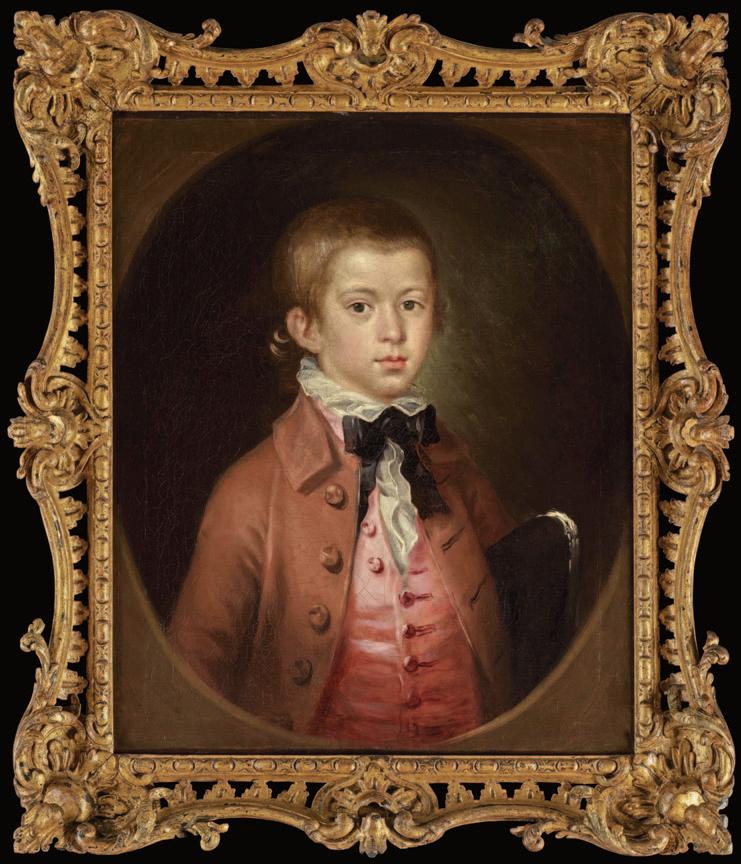
CAT. 2
Nathaniel Dance, R.A. (1735-1811)
Powlett Wright
Oil on Canvas
28 by 36 inches, 71 by 91 cm
Frost and Reed label verso
Provenance: Presumably commissioned by the Wrighte or Benyon family; George J. Kidston (1873-1954) of Hazelbury Manor, Box, Wiltshire; With Messrs Frost and Reed; Private Collection U.S.A.
This charming and archetypical English country house picture, recently come to light, has been identified, in terms of artist, sitter and house, from another version of the work, which is still in the collection of the Benyon family of Englefield, the descendants of the sitter in this painting and still the owners of Englefield House.

In terms of our artist, Nathaniel Dance, 1760 was a pivotal year for him. Initially it is hard to reconcile this picture stylistically with most of the known works by Dance. But if we keep the date of 1760 in mind, we note that this pre-dates his all-important trip to Italy, from which he would return after a few year’s study and having worked with no less a figure than Pompeo Batoni in Rome. The Dance that returned from Italy was a fully mature artist who would in the 1770s produce portraits and conversation pieces of great sophistication. The Dance of the late 1750s was a young man
just emerging from his pupillage with the by now oldfashioned Francis Hayman. Plus the full attribution of the Englefield version to Dance and the identical attribution on the Frost and Reed label on this present picture, when the two paintings have been apart for at least 100 years or more cannot be explained by co-incidence. And we should add to that the fact that there is a definite link between the Dance family of artists and the East India Company. A cousin of our artist, another Nathaniel Dance, rose to great prominence as a ship’s commander, patronized by the East India Company.
We can safely conclude that our picture is a charming early work in the mid-eighteenth century tradition of the English country house conversation piece. Beyond that it is a picture of both sociological and topographical interest. We are looking at an important Berkshire house as it appeared in the years around 1760.
CAT. 3
Pastel
27 by 22 inches, 68.5 by 56 cm
Frame: 18th century carved wood frame, re-finished Provenance: Private Collection, London since the 1960s
Born in Dundee in 1723 Catherine Read came from a family with strong Jacobite leanings. Indeed her uncle, Sir James Wedderburn, had been executed for the part he played in the 1745 rebellion. Initially she must be classified as largely selftaught, beginning to earn something of a living and a reputation by painting and drawing the ladies and their children of her local acquaintance
At her best Catherine Read could paint and draw extraordinarily well. She had not perhaps the characterization of Latour, but plenty of her productions did in the end rival those of Carriera. In England, following the death of Francis Cotes (1726-1770), the pastel field was effectively hers. More remarkable though is the fact that as a woman - of some birth and education but unmarried and financially unsupportedshe managed to live by her art in the middle of the 18th century. Contemporary criticisms of her work range widely, but it is telling that she was so often the subject of comment. Amusing to note also is that she seems to have presented herself without any airs and graces. By all accounts her personality was on the dour side and her appearance quite unkempt. Not an asset for the portrait painter one would have thought, who must of necessity flatter. But it does give the art-historian the sense that she was totally devoted to her art. In the current climate, where concern to give female artists their due is growing, Catherine Read is rather naturally being re-assessed. It is becoming apparent that in the two and a half centuries
following her death, many of her portraits have been given to other artists; the pastels to Carriera and Cotes; the oils to Reynolds and Ramsay in particular. This is changing now. In Dundee in 2021, the McManus Gallery’s acquisition of Read’s remarkably proficient oil painting of Lady Glenorchy is testament to this overdue trend of her proper recognition. It is thoroughly appropriate that a Scottish public gallery should be interested to acquire a major work by this highly singleminded Scottish female artist
This present picture is a good, big and thoroughly representative example of Read’s work in pastel. Rather more ambitious in composition than her usual single figures, this double portrait shows considerable skill in her intertwining of her two sitters. Her colours here, light blues, greys and whites – typical of her and typical of the classicizing tendencies of late 18th century artists - combine harmoniously and the addition of sheet music, underlining the girls’ artistic interests, is an attractive touch. It is nearly impossible to identify her works with those she exhibited publicly, as for the most part these appear anonymously under ‘Portrait of a Lady’ etc. But given the relative rarity of a double portrait in her oeuvre, we may be looking here at her 1769 exhibit at the Society of Artists. Her work shown as number 147 in that exhibition was entitled ‘Portrait in crayons of two young ladies’. The subject fits, the medium fits and the date is totally plausible

CAT. 4
Sir Thomas Lawrence, P.R.A. (1769-1830)
Portrait of a Gentleman
Half-length, wearing a blue coat and white short and stock Pastel, oval 9 ½ by 7 ½ inches, 24.2 by 18.9 cm
Provenance: Sir Horatio D Davies K.C.M.G. (1842-1912), Watcombe Hall, Torquay; His sale Christie’s 17th February 1913, lot 2
This is a rare early pastel portrait by Lawrence dating from his years in Bath. Following his father’s bankruptcy, Lawrence and his family moved to the city in 1780, where the teenage artist embarked on his early career, as a portrait painter specialising in pastels. There was a keen demand for pastel portraits in the city and Lawrence rapidly established himself with a ready stream of sitters. By 1783, he was able to charge 3 guineas for a half-length and within four years had increased this to 5gns.
In 1787 the Lawrence family moved to London and the young artist enrolled at the Royal Academy Schools and exhibited at the Academy for the first time. His first exhibited works in London were pastel portraits, however by 1790, the artist had largely abandoned the medium, turning instead to oils. In 1794, Lawrence became a member of the Royal Academy and was appointed Painter-in-Ordinary to King George III. He was knighted in 1815 and made President of the Royal Academy five years later.
The confident and sophisticated handling of the present flamboyant, lively portrait, with the careful, detailed application of the medium, amply demonstrate Lawrence’s facility with pastel The fabric swag behind the sitter became a popular motif in the artist’s work.
A previous owner of the picture, Sir Horatio Davies
(1842-1912) was a self-made London businessman, politician and magistrate, who was the driving force behind the establishment of the drink Pimm’s as an international brand name. He formed a notable art collection.

CAT. 5
John Russell, R.A. (1745-1806)
Portrait of Alexander Mitchell of Stow, Midlothian
Half-length, in painted frame Signed on painted frame lower left: J Russell R.A. pinx.t/1790
Pastel
23 ½ by 17 ½ inches, 60 by 44.5 cm
Provenance: By descent from the sitter to Fanny Georgina Jane Mitchell, later Lady Reay (d.1917); Her second husband, Donald James Mackay, 11th Lord Reay (1839-1921); Given to his godson Captain Hubert Charles Poulet Hamilton of Moyne House, near Durrow, Co. Laios, Ireland (1915-2007); By descent until 2017
John Russell R.A. was one of the most sought after portrait and fancy painters of the late eighteenth century. He was initially apprenticed to Francis Cotes, R.A. (1726-1770) in about 1767, before enrolling in the Royal Academy Schools in 1770, where he won the School’s Gold Medal that year. He was appointed Associate of the Royal Academy in 1772 and became a full member in 1788. The following year, Russell was appointed Painter to King George III, the Prince of Wales and the Duke of York, posts he held until his death from typhus in 1806.
From the 1770s, Russell began to work extensively in pastel and these boldly coloured, technically brilliant works found a ready market and the artist received a constant stream of commissions. He was experimental in his use of pastels, working out his preferred support, favouring a thick blue paper, often backed on linen; creating his own pastels, mixing the pigments on a grindstone and rolling and shaping them with points at both ends. He perfected a method of working by smoothing and blending the pastels with his fingers and highlighting details with black chalk. In 1772, Russell published his detailed account of pastel painting, Elements of Painting with Crayons, which was later revised and enlarged in 1777 and remained popular throughout the 19th Century.
The present portrait dates from 1790, when Russell was at the heights of his powers and shortly after his Royal appointments.

Inscribed on an old label attached to the backboard: Miss Fanny Andrews 1794 a Study for the Picture/ of Fanny in Dr Downman's poem of The Land/ of the Muses as added to Spencer's Fairy Queen/ She was niece to Mr Downman and Cousin to Lord Courtenay
Pencil and watercolour 8 ¾ by 7 ¼ inches, 21 by 17.8 cm
Provenance: Captain Norman Colville (1893-1974); Peter Chance (1911-1985); Private Collection, UK
Downman established a career as one of the leading portrait painters of the late eighteenth century, specialising in producing small scale works usually in watercolour, although he did also work in oil. He painted the most fashionable figures of the day, including several members of the Royal Family, the Duchesses of Devonshire and Richmond, and actresses such as Mrs Siddons and Miss Farren. A review on 4th May 1786 in the Morning Post praised Downman’s work as ‘universally admired & sought after by the first people of rank and taste’ (quoted in William T Whitley, Artists and their friends in England 1700-1799, 1928, vol. 11, p. 212).
Settling in London aged seventeen, he became a student of Benjamin West, P.R.A. (1738-1820), at a time when the latter was approaching the height of his fame. He was then amongst the first group of students to study at the nascent Royal Academy Schools in 1769. Despite his early involvement with the Academy and his close relationship to its second President, Downman, appears to have had a somewhat uneasy relationship with the institution. He was appointed Associate Member in November 1795, but never achieved full membership. Although he exhibited regularly between 1770 and 1819, he had frequent confrontations with the hanging committee about the positioning of his works and there were years where he either did not exhibit, withdrew his work, or held his own exhibitions elsewhere. He was not the only artist to struggle with the hanging committee, many other celebrated artists including Gainsborough had similar issues.
The present work is an illustration of Fanny Andrews, a character in the poem, ‘The Land of Muses’, by John Downman's cousin Dr Hugh Downman (1740-1809), published in 1768, whilst the latter was still studying medicine at Edinburgh. Hugh practiced as a doctor and was highly regarded for his amiable and kind personality, moral standing and for being an able doctor. He had a strong literary interest and wrote several poems, a number of plays and helped translate an edition of Voltaire’s work. His most successful poem, 'Infancy of the management of children: a poem in three books' (1774-6) ran to nine editions during his lifetime.

CAT. 7
An Execution outside Newgate Prison, London
Pen and brown ink and watercolour over pencil 7 by 10 ½ inches, 18.3 by 26.8 cm
Provenance: Anonymous sale, Christie's, 3rd October 2001, lot 391; Private Collection until 2018
Rowlandson has depicted the huge crowds that filled every available vantage point on execution days at Newgate Prison, even climbing up the sides of buildings and onto the nearby roofs. Street sellers can be seen in the foreground, plying goods to the watching crowds. The austere mass of Newgate prison, visible behind the crowds of people, was built by George Dance the Younger. It was begun, on the site of an earlier prison, in 1770, but was badly damaged by fire during the Gordon Riots in 1780 and had to be extensively rebuilt. On its completion in 1782, London's gallows were moved from Tyburn to Newgate and every Monday morning large crowds would assemble outside to watch.
Another view of the same subject by Rowlandson is in the London Museum with another recorded in the collection of Desmond Coke
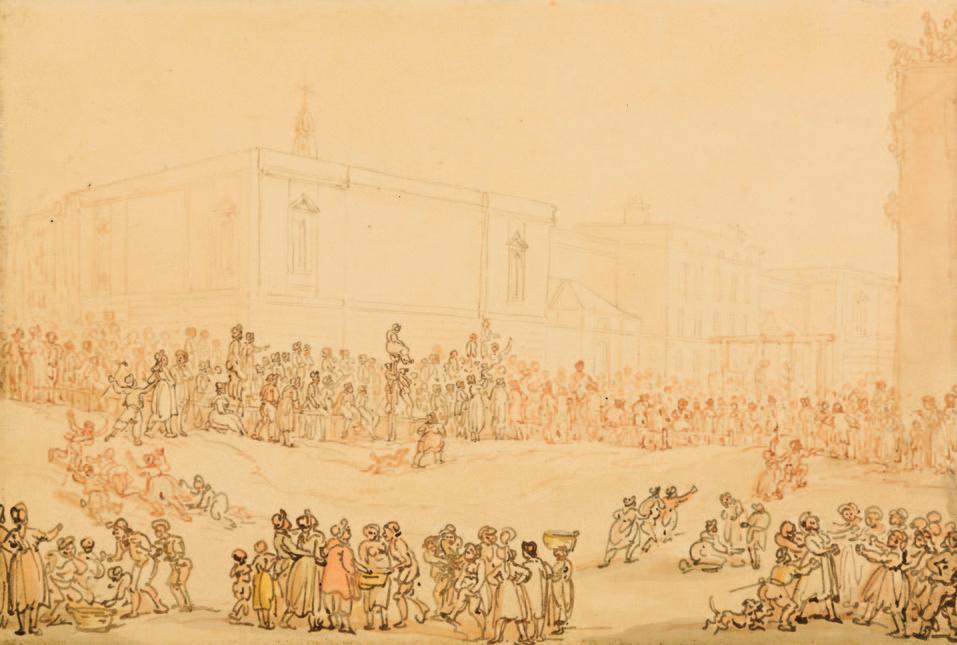
CAT. 8
Ladies in a Box at the Theatre
Numbered 63 on the mount
Pen and grey ink and watercolour over pencil
5 by 7 ½ inches, 13.2 by 18.9 cm
Provenance: The Hospital of La Providence, Rochester
A related sketch by Nixon drawn at the Paris Opera and dated 1802 was with Abbott and Holder. Nixon was an amateur caricaturist who worked as a merchant in business with his brother in London. His work shows the influence of the best known caricaturist of the period Thomas Rowlandson (1756-1827) with whom he sometimes travelled on sketching tours, and like the present drawing are often lively in execution.
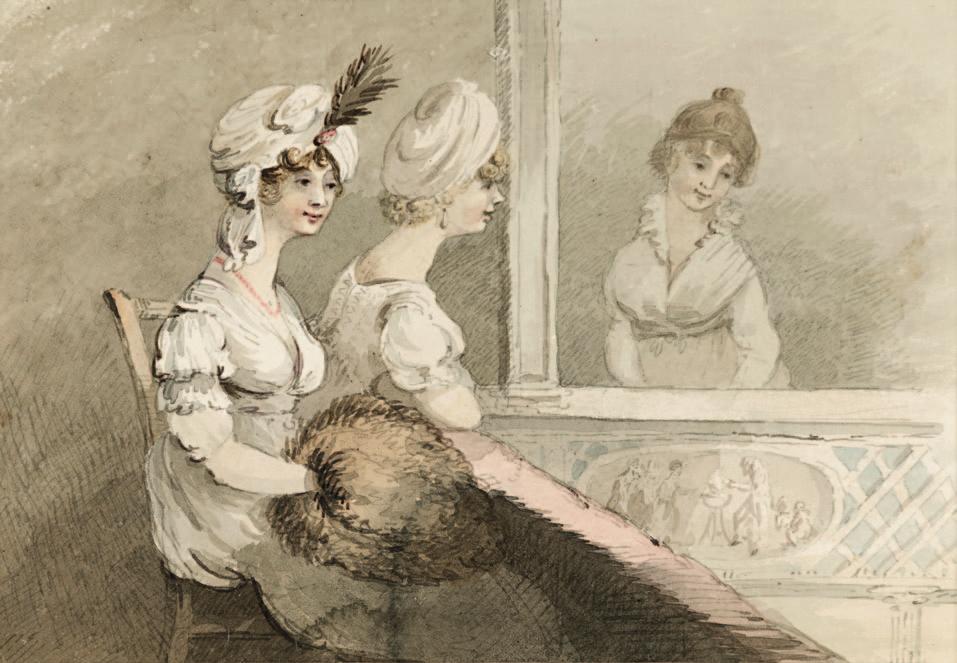
CAT. 9
George Romney (1734-1802)
Studies for ‘Viscountess Bulkeley as Hebe’
Brown washes over pencil on laid paper 12 ½ by 11 ¼ inches, 31.8 by 28.8 cm
Provenance: R.C. Harford; Anonymous sale Christie's, 6th June 1972, lot 90; With Thos. Agnew & Sons (stock no.28749); Private collection, UK
Elizabeth Harriet Warren (1759-1826), later Viscountess Bulkeley, was the daughter of Sir George Warren of Poynton, Cheshire and Romney painted a group portrait of the family in 1769. Sir George commissioned a further full-length portrait of Elizabeth, presumably to mark her forthcoming wedding, to Thomas, 7th Viscount Bulkeley of Beaumaris (1752-1822) in April 1777. She sat to Romney on five occasions during May 1776, with a final sitting in D ecember (Romney had fallen ill in the intervening period). The finished painting is now in the collection of the National Museum of Wales, Cardiff.
Romney chose to depict the sitter as Hebe, cupbearer to the gods and goddess of youthful beauty, a popular allegorical identity for young women of the period. The freedom of handling, dramatic pose and sublime surroundings, however, depict the subject in a very different manner to those of many of his contemporaries. It marks a watershed in Romney's stylistic development, following his return from three years in Italy and the influence of artists such as Henry Fuseli, whom he met there
Although Romney often produced detailed studies for his historical paintings, it is relatively unusual for him to produce a number of such works for his portraits. Apart from the current study, there are several other preparatory sketches for the Bulkeley portrait including a related study, showing a single figure in a similar pose to the present drawing, in the Yale Center for British Art, New Haven, with another in the Morgan Library, New York.

CAT. 10
James Ward, R.A. (1769-1859)
A study of Lord Chesterfield's Hand
Signed with monogram and inscribed lower left: Ld Chsterfield's hand - for the large picture Black and red chalk and stump on wove paper watermarked J Whatman/1811 9 by 10 inches, 22.9 by 25.7 cm
The present drawing is a study of the right hand of George Stanhope, 6th Earl of Chesterfield (1805-1866), for Ward’s large scale painting of Lord Stanhope, Riding a Pony, now in the Birmingham Museums and Art Gallery. There is a detailed drawing of the composition in the Yale Center for British Art, New Haven. Ward also painted a portrait of Lord Chesterfield’s niece and daughter.

Lord Stanhope succeeded his father as the 6th Earl of Chesterfield in 1815, at the age of 10, the year the related painting was completed. He was passionate about sport including cricket, sailing and in particular horseracing. He had a good eye for bloodstock and his horses won the St Leger,
the Oaks and the Grand National on various occasions. A newspaper report about the Earl’s character in the Derby Mercury in 1860 said of him ‘succeeding to a vast fortune and the accumulation of a long minority, under careful trustees, there was none to prevent his Lordship from indulging those tastes for the turf, the chase and the road which seemed born with him and which have since given him such a conspicuous position among the sporting noblemen of the age’. However, his success on the track, was not sufficient to fund his horse racing and by the time he was 30, he had lost nearly half his fortune. Finding himself unable to continue to fund his lavish lifestyle, he retired to Bretby Hall, Derbyshire
CAT. 11
The Capuchin Monastery at Amalfi, Italy
Signed on reverse of original mount: Convent near Amalfi in the Bay of Salerno/John Smith. 1808. Watercolour over traces of pencil 8 ¾ by 11 ¾ inches, 22.3 by 29.9 cm
Provenance: With Thos. Agnew & Sons (stock no.47206), 1980s
Exhibited: London, Society of Painters in Water-colours, 1808, no.178 as ‘Convent near Amalfi in the Bay of Salerno’

John ‘Warwick’ Smith spent five years in Italy, from 1776 until 1781 at the expense of his patron the 2nd Earl of Warwick. While there, he sketched with Thomas Jones and returned to England via Switzerland with Francis Towne. Smith was based in Naples for sixteen months from March 1778, frequently sketching with Thomas Jones from September 1778. Smith rented a house at Vietri on the Bay of Salerno each summer and visited nearby Sorrento in November 1778.
This is a view of the Capuchin Monastery outside Amalfi, now the Convento di Amalfi hotel The complex dates from the early thirteenth century when it was built by the Cistercians. From 1583 it was entrusted to the Capuchin Friars and was first used as a hotel in 1885.
Another version of this watercolour, probably drawn on the spot, is in Manchester Art Gallery.
CAT. 12
Sir William
Beechey (1753-1839)
Portrait of a Young Boy holding a Book
Oil on canvas
30 ½ by 24 ¾ inches, 77.5 by 62.9 cm
Sir William Beechey had a long and illustrious career as one of Britain’s foremost portrait painters. He started out as a pupil at the Royal Academy, studying predominantly under Zoffany. His reputation was to form quickly and in the 1780s he was already exhibiting prolifically. By 1793 he was elected as an Associate Member of the Royal Academy and that same year, having painted a portrait of Queen Charlotte, was given the title “Portrait painter to her Majesty”. By 1797 he was a full member of the R.A. and was knighted in 1798.

This present picture, a charming portrait of an un-named boy is an excellent example of Beechey’s earlier work, when Reynolds was clearly an influence. He has even borrowed that
kind of ‘impish’ face that Reynolds often pressed into service with his own younger sitters and his ‘fancy’ pictures. But there is also a marked vigour and freedom of brush-stroking visible here, which reminds us of Beechey’s own particular virtuosity. The colour scheme and the vibrant presentation of the sitter
- and indeed the costume and hairstyle - would point to Beechey’s work from the 1790s. A comparison with his ‘BeggarBoy’ picture of 1793 in Tate Britain is instructive
We are grateful to Dr Brian Allen, Chairman of the Art Fund and Trustee of the National Portrait Gallery, for confirming the attribution to Beechey.
CAT. 13
Henry Edridge (1768-1821)
Portrait of a Young Gentleman
Pencil, and grey wash 16 by 11 inches, 41 by 28 cm
Henry Edridge was a competent miniature painter and tried his hand at oils. But at the end of the 18th century and during the Regency times he developed a highly popular form of watercolour portraiture – and it is on these that his reputation now rests. These pictures were slightly unusual in that, although small in scale, they almost inevitably depicted their subjects full-length. It has been said that you can follow the
development of English fashion by looking at Edridge’s works, which take the viewer from the powdered and bewigged men and women of the 1780s through to the much more pared down classical styles of the late Regency period.
This elegant figure, dateable to the years 1800-1810, is typical of Edridge at his best

CAT. 14
The Return of the Wandering Father, Fiesole, Italy
Signed with initials, dated and inscribed lower right: Il ritorno del Padre ambulante/A Fiesole. GH. 1847. London Pen and brown ink and watercolour over pencil 15 ¾ by 10 ½ inches, 44 by 27 cm
In the autumn of 1816, Hayter undertook his first visit to Italy, settling in Rome, where he remained until 1818. He returned in September 1826 when his unorthodox lifestyle hampered his career progression in England and this time he settled in Florence. However, he only remained in Italy for just over a year, when the scandal following the death of his mistress, when she accidentally poisoned herself with arsenic, meant he had to leave
Despite his personal setbacks, Hayter's professional success in Italy is evident. He was elected an honorary member of the
Accademia of San Luca in Rome in 1816 and later was also elected to the academies of Florence, Bologna and Palma.
The studies that he made during his Italian visits, continued to supply the artist with material for many years after his return, as evidenced by the present watercolour.

CAT. 15
The Church of the Virgin Mary and St. Charlemagne, Prague
Inscribed lower right: Prague/St Charles Pencil and stump heightened with white 10 ¼ by 15 ½ inches, 26.2 by 39.5 cm
Provenance: The Artist’s studio sale, Sotheby’s, 21st May 1852, lot 36; Anonymous sale, Sotheby’s, 24th September 1987, lot 205, one of two; With Spink, London; Anonymous sale, Bonham's, 6th June 2006, lot 44
The present drawing depicts the Church of the Virgin Mary and Saint Charlemagne, built on Mount Charles, the highest point in the new town of Prague. In September 1350, Charles IV personally laid the foundation stone for the church which took 27 years to build.
Samuel Prout developed a reputation for depicting detailed topographical studies, particularly of continental architectural views and he travelled widely throughout Europe in order to find suitable subject matter. He visited Prague in 1829, the year he was appointed Painter in Ordinary in Watercolours to George IV. He arrived in early September and made at least 17 drawings while he was there all on similarly sized sheets. These were the basis for finished watercolours executed later

in the studio. Other examples are in the British Museum, the V & A, Birmingham Museum, the Fitzwilliam, Cambridge and Plymouth Art Gallery.
This trip proved hugely successful and as a result, he produced a series of lithographs entitled, Facsimile of Sketches made in Flanders and Germany, published in 1833, which included five views of Prague. Treatises and books on travel became hugely popular in the nineteenth century, and Prout’s publication was in the vanguard of these. It proved influential on many of Prout’s contemporaries, including Thomas Shotter Boys, David Roberts and John Ruskin, who was directly inspired to undertake his first visit to Europe.
CAT. 16
In the Grounds of Shrubland Park, Suffolk
Coloured chalks on buff paper 11 by 9 ¾ inches, 28.2 by 24.8 cm Suffolk born Bright trained under the painter Alfred Stannard (1806-1889). In 1836 he moved to London and exhibited at the British Institution and the Liverpool Academy, as well as at the Royal Academy between 1843 and 1850. He was a member of the New Society of Painters in Watercolour between 1839 and his resignation in 1845. Throughout his career, Bright was an active member of the Norwich School of Painters. In 1805 it became an exhibiting society as well, the first such outside London. The Norwich School continued to flourish through most of the nineteenth century.
The current house at Shrubland Park, near Coddenham, Suffolk, was designed by James Paine and built in the 1770s. Sir William Middleton purchased the estate in 1788 and commissioned Humphrey Repton to suggest improvements, some of which were carried out. His son Sir William Fowle Middleton inherited the estate in 1830 and developed an elaborate series of terraced gardens, which were further developed in an Italianate style by the architect Sir Charles Barry (1795-1860). The house descended by marriage to the Barons de Saumarez until the estate was sold in 2010. Bright exhibited ‘In Shrubland Park’ at the New Society of Painters in Water-colours in 1840, no.210.

CAT. 17
Robert Hills (1769-1844)
Study of the Head of a Buffalo
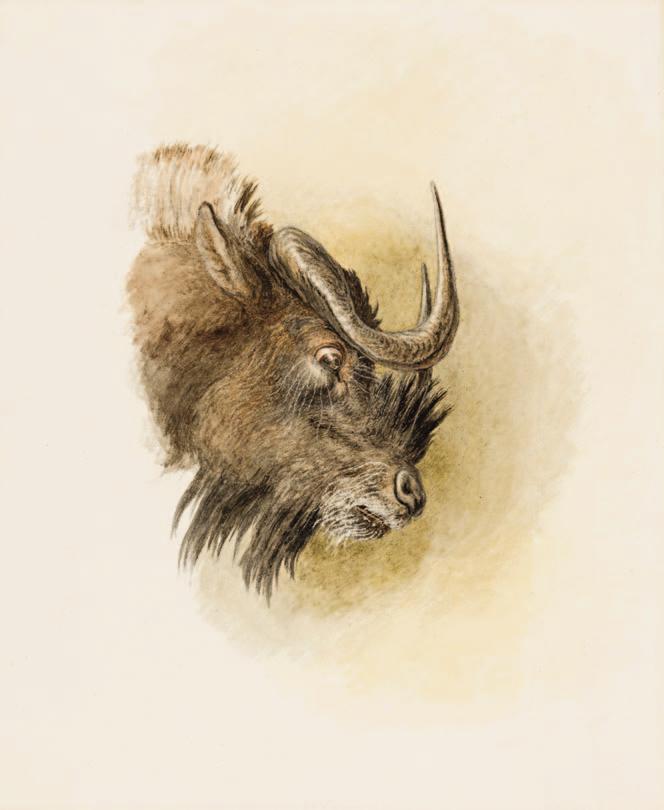
Watercolour over pencil heightened with scratching out 10 ¼ by 8 ½ inches, 26.6 by 21.6 cm
Hills entered the Royal Academy schools in 1788 and exhibited his first picture there in 1791. In 1804 he became a founding member of the Society of Painters in Watercolour, later serving as its treasurer and then, for twenty-one years, its secretary. He established a reputation as a landscape and animal painter and in particular for producing highly detailed, accurate likenesses of all sorts of animals both wild and domestic, characterised by a delicate use of colour and line. Between 1795 and 1815, Hills published nearly 800 animal studies for his extensive series Etchings of Quadrupeds
Innovations in livestock breeding during the late eighteenth and early nineteenth centuries led to artistic commissions from breeders keen to record their successes. Thomas Sidney Cooper, James Ward and Robert Hills were amongst the artists who were most sought after in this field. However, as well as depictions of domestic livestock, there was demand for wild and exotic animals housed in the various menageries and zoos. Where Hills would have seen the buffalo depicted here, is uncertain but London Zoo is recorded as having a Cape Buffalo, housed in its oval, Tuscan style cattle shed during the 1830s.
View of Polesden Lacey, Surrey seen through Trees
Watercolour over traces of pencil heightened with gum arabic 14 ½ by 10 ½ inches, 37.2 by 26.7 cm
Polesden Lacey is located on the North Downs near Dorking and is now a National Trust property. John Varley first visited Polesden Lacey with Dr Thomas Monro (1759-1833), who lived in nearby Fetcham in 1800 when the house belonged to the playwright Richard Sheridan (1751-1815). Dr Monro was an early supporter and patron of Turner and Girtin whose works Varley would have seen in his collection. He was the physician at Bethlem Hospital and his London house on Adelphi Terrace off The Strand became a magnet for young artists.
This watercolour belongs to a group of views taken at Polesden Lacey in the late 1820s.

CAT. 19
Shipping off Greenwich
Signed on sail: D. Cox
Watercolour over traces of pencil heightened with bodycolour and scratching out
6 by 8 ¾ inches, 15.6 by 22.6 cm
Provenance: Bought at the Fine Art Society, London, by 1962; By descent until 2019
Cox drew a number of views on the Thames in the late 1820s and early 1830s.

CAT. 20
Kranichstein Castle, Darmstadt, Germany
Signed lower left: Krantchstein/T.S. Boys 63
Watercolour over traces of pencil heightened with bodycolour 13 by 18 inches, 33 by 45.4 cm
Provenance: With Thos. Agnew & Sons (stock no.38225)
Exhibited: London, The New Watercolour Society, 1863, no. 179 as ‘The Castle at Kranichstein, near Darmstadt; belonging to HRH the Grand Duke of Hesse Darmstadt. From a sketch by Mr Montague Cooke ’

Boys travelled extensively throughout his life, both in Britain and Europe. His sister Mary and brother-in-law William John
Cooke, cousin of the celebrated marine artist Edward William
Cooke, R.A. (1811-1880) and fellow pupil of George Cooke, moved to Darmstadt in 1840 and Boys visited them several times in 1842 and 1843.
This watercolour is based on a work by William Montague
Cooke, Boys’ nephew, who gave drawing lessons to the
children of Princess Alice, grand duchess of Hesse and of Rhine. The family of Hessen-Darmstadt ruled the Darmstadt area of Germany from the mid sixteenth century. In 1578, Count George I, commissioned the palatial Jagdschloss Kranichstein to be built in the north of the city, as his hunting lodge, surrounded by vast forests. In 1917, the palace was opened as a museum and the complex today also includes a
small natural history museum, a hotel and restaurant, with a huge public park in the former hunting grounds.
CAT. 21
Thomas Miles Richardson Senior (1784-1848)
Sunset after the Storm
Signed lower right: TR 1837 Watercolour heightened with bodycolour and scratching out 8 ¼ by 12 inches, 21.4 by 30.7 cm
Richardson was born in Newcastle, the son of the Master of St Andrew’s Grammar School. He was initially indentured to a cabinet maker, before altering tack and becoming an artist. He exhibited regularly at the Royal Academy and the British Institution in London and the Royal Scottish Academy. He was instrumental in setting up various societies to help promote and exhibit art in Northumberland and encourage artists in the North East of the country. In 1822 he co-founded the Northumberland Institution for the Promotion of the Fine Art and five years later helped to establish the Northern Academy. Although he did visit London and travelled to Scotland and Wales, he found most of his inspiration in the landscape of Northern England.

CAT. 22
Interior of a Painter’s Study –Edwin Landseer (1802-1873) at his easel
Oil on Canvas
30 by 25 inches, 76.5 by 63.5 cm
Provenance: Ernest J.C. Savory, Orsett Terrace, London; Christie’s London 19 May 1899 Lot 82 (as Wilkie School – An Artist’s Studio); Bought Leggatt Bros; Private Collection USA
Exhibited: London, British Institution, 1830, No 81
This highly engaging picture, coming to light after more than 100 years of obscurity, shows Sir Edwin Landseer, perhaps England’s greatest ever animal painter, at still only some 20 years of age, in the process of creating one of his early masterpieces, The Larder Invaded (1822). The artist is seated at his easel, where that picture is positioned. In the foreground another young man – most probably John Hayter the painter himself – is urging a dog on to enrage a cat, whom we see perched up on the right hand margin of the picture. Landseer turns to sketch this cat with its arched back and outraged expression.
Landseer’s paintings, hugely popular in his lifetime have never been out of fashion, but his own image is less well-known. Those images which are in the public sphere tend to show him in his pomp as a middle or late-middle aged man. Francis Grant’s portrait of him in the National Portrait Gallery – and its variants – or Landseer’s own self-portrait working while observed by two dogs in the Royal Collections are perhaps the best known. But images of Landseer as a young man are not at all common and a full exhibition picture of him in his early days – and at his easel painting - is a considerable rarity. That the artist at the easel is Landseer is easily demonstrated. First it looks exactly like him as he appears in early drawings by both Hayter brothers, John and George. Similarly, in John Hayter’s A Controversy on Colour (now Shipley Art Gallery,
Gateshead, UK), Landseer again appears among the Hayter family with identical features. But of course the work on the easel in this picture is clearly Landseer’s Larder Invaded, known to us today through sketches and engravings. The Larder Invaded, a prizewinner at the British Institution in 1822, was in fact the picture that had propelled the young Landseer to fame. So it was probably quite a canny marketing strategy by John Hayter to show, at that very same venue, a picture of his friend the now famous Edwin Landseer, in the act of creating this celebrated British Institution painting - and to show it in 1830, which was the year that Landseer had also just been elected to full membership of the RA.
This re-discovered painting is thus a remarkable document showing us exactly how Edwin Landseer set about painting his pictures. We can sense Landseer and Hayter as ambitious young artists setting out on their journeys and the scene has that appealing combination of high jinks and serious endeavour often associated with young painters. But how Landseer contrived to paint his animals with the expressions he gave them has long fascinated the public. The emergence of Hayter’s painting, showing us the specific manipulations that Landseer employed, goes a long way to answering this question. This is both a delightful painting and a most welcome addition to our body of knowledge of one of England’s greatest painters.


CAT. 23
Henry Thomas Alken (1785-1851)
Scenes from the Hunting Field – a pair
Pencil and Watercolour 11 by 15 inches, 27.9 by 38.1 cm
The Alken family was one of those illustrious families of sporting artists who flourished in England the late 18th and early 19th centuries – the hey-day of the English sporting scene There were at least 6 members of the family who were practising artists, but of these Henry Thomas Alken (or Henry Alken Senior as he was also known) was the most accomplished. He turned his hand to racing, hunting, fishing
and shooting subjects with equal dexterity and showed himself to be similarly adept as an oil painter, watercolourist and soft-ground etcher. With his meticulous approach to detail, he has left us a body of work which is an invaluable record of field-sports in England from the early Regency period right through to the mid-Victorian era.

CAT. 24
Andrew Nicholl, R.H.A. (1804-1886)
Cattle grazing by a river, Windsor Castle beyond
Signed lower left: A. Nicholl R.H.A. and inscribed verso: Windsor Castle from the bend of the River Watercolour over pencil heightened with bodycolour and scratching out 12 ¾ by 20 inches, 32.5 by 51.2 cm
Nicholl was born in Belfast. He was elected an Associate of the Royal Hibernian Academy in 1827, and full member in 1860. He visited London for the first time between 1830 and 1832. He returned to Ireland but was in London again in 1840. Six years later, he travelled to Sri Lanka, to take up a teaching position at Colombo Academy, where he stayed until 1849. He appears to have spent the rest of his life, between Belfast and London and died at his London home in Camberwell at the age of 82.
The present watercolour is characteristic of the artist, with a carefully depicted botanical subject in the foreground combined with a sense of romance, conveyed by Windsor Castle against a dramatic skyline. The view is taken from a low viewpoint on the Eton bank of the river Thames.
The extensive use of scratching out is typical of the artist and is used here to bring the foreground to life
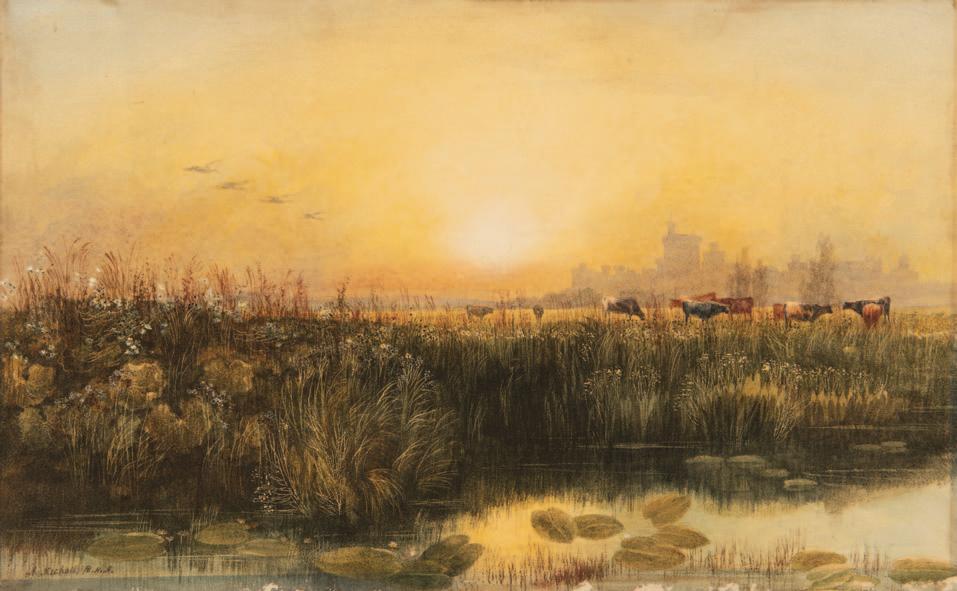
CAT. 25
Andrew Nicholl, R.H.A. (1804-1886)
View of Clifden, Connemara, Ireland, with the Twelve Pins beyond
Signed lower right: A. Nicholl R.H.A.
Watercolour over pencil, heightened with white 19 ¾ by 27 ¾ inches, 50.4 by 70.7 cm
This is a view of the town of Clifden, Co. Galway seen from the west. Beyond are the mountains known as the Twelve Bens or Twelve Pins of Connemara. Clifden was built by the owner of the land John D'Arcy in 1812. The first church in Clifden, St Mary's, visible on the hill to the left, was built in 1824 by the Rev. Myles Prendergast with the help of D’Arcy. It was replaced by a new church between 1853 and 1864. It was joined by the nearby St Joseph's church in 1879.
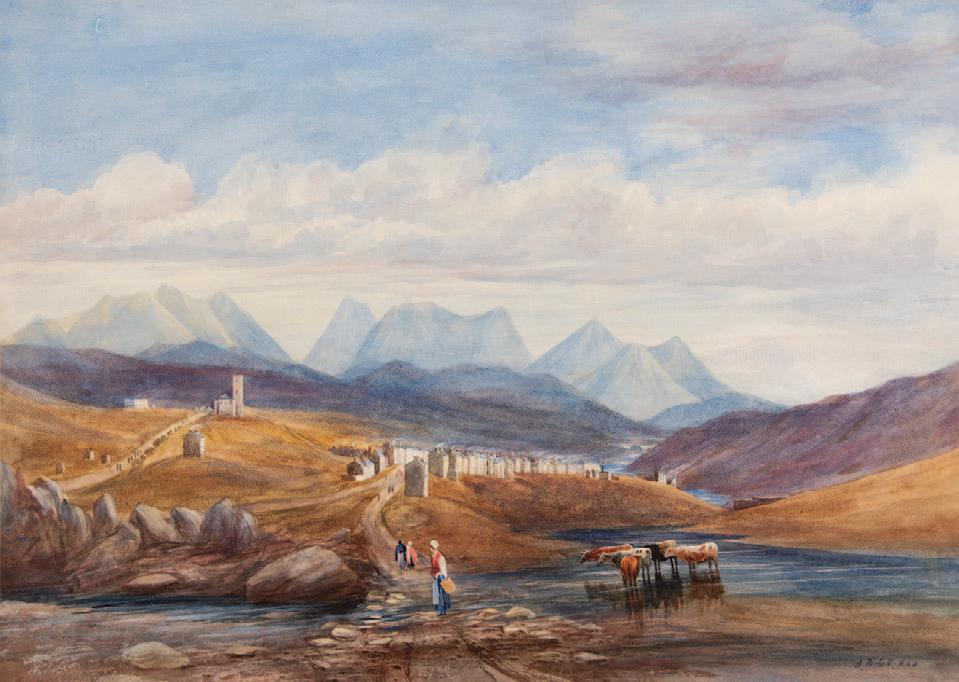
CAT. 26
e
Portrait of Henry and Philip Fletcher
Coloured chalks on paper laid on canvas 24 by 24 ½ inches, 61 by 61.5 cm, Oval Literature: Raymond Lister, George Richmond, 1981, p.158, no. 46 Richmond became one of the periods most sought after portrait painters, commissioned by the wealthy industrialists, the gentry, nobility and members of the royal family. He came from a long line of artists, his father Thomas was a miniaturist, as was his great-great-grandfather, George Engleheart. He entered the Royal Academy Schools in 1824 and became part of ‘The Ancients’, the group of followers of William Blake, who Richmond had met at the age of 16, through the artist John Linnell. Blake became a close friend, as well as important influence, on the younger man; Richmond was at the poet’s bedside at his death. Richmond’s success as a portrait painter, led to his being elected Associate of the Royal Academy in
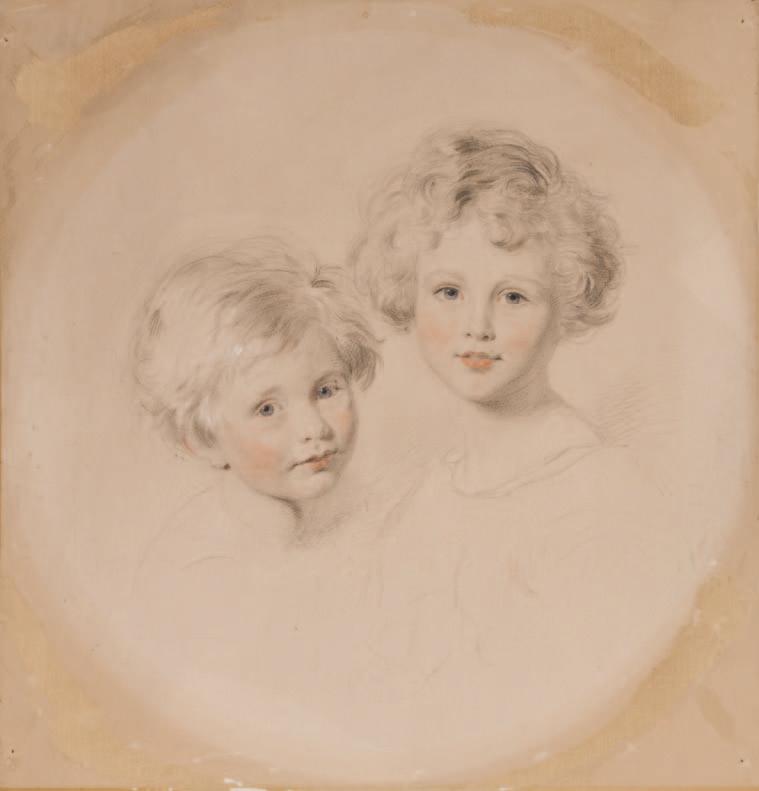
1857 and Academician in 1866. He also served on the royal commission for selecting the site of the National Gallery.
The present portraits depict Henry Charles Fletcher and his brother Philip, the sons of Major General Fletcher of the Scots Guards and his wife the Hon. Mrs Ellen Shore. Henry followed his father into the army and was later a Lieutenant Colonel in the Scots Guards. This portrait is dated in Richmond’s stockbook to February 1840 and was sold for £31.10, described as ‘Captain Fletcher's Two children.’ Richmond drew a number of members of the Fletcher family between 1831 and 1850.
CAT. 27
William Wyld
Sunset on the river Elbe, Dresden, Germany
Signed in red lower right: WWyld Watercolour heightened with bodycolour 4 ¾ by 7 ½ inches, 12 by 19 cm

This is a view of the left bank of the Elbe looking upstream with the Augustus Bridge to the left. The three visible monuments are, from left to right, the Frauenkirche (destroyed in World War II), the tower and nave of the Catholic Palace Church and the tower of the Dresden Schloss
Another version of this view by Wyld is in the Victoria and Albert Museum (see Marcia Pointon, Bonington, Francia and Wyld, 1985, no. 29, ill). A smaller version was sold as part of the collection of Gerald Bauer at Christie’s on 22nd January 2003, lot 57.
A diplomat and later wine-merchant who spent most of his life in France, Wyld began his career in 1826 as Secretary to the British Consul in Calais, where he was a pupil of Francia.
Strongly influenced by Bonington whose work he knew, Wyld visited Algeria in 1833 in the company of the French artist Horace Vernet
CAT. 28
William Callow, R.W.S. (1812-1908)
View of Melrose Abbey from the Banks of the River Tweed
Signed lower left and indistinctly dated Watercolour over pencil heightened with touches of bodycolour and scratching out 14 ¼ by 21 ½ inches, 36.5 by 54.9 cm
At the age of thirteen, William Callow was apprenticed as a pupil in engraving and watercolour painting, to Theodore Fielding. Four years later, in 1829, he was sent to Paris to work with another member of the influential and extensive Fielding family, Newton, whose successful studio required help. Callow settled easily into life in Paris, he became friends with Thomas Shotter Boys (cat no. 20) who was also in Paris at the time and was influenced not only by Boys but by the work of the late Richard Parkes Bonington (1802-1828).
On gaining his independence from pupillage in 1833, Callow remained in Paris and established himself as watercolourist and drawing master, building up a flourishing practice Amongst his pupils were members of the family of King Louis
Philippe, whose daughter, Princess Clémentine, became a pupil of Callow for seven years and a lifelong friend. Despite this success, in 1841, Callow decided to move back to London, where although he was little known to the general public, his watercolours found an enthusiastic audience and he quickly established his teaching practice, finding similarly wealthy pupils.
Callow visited Melrose in the summer of 1843 on his way home from Edinburgh. This watercolour is likely to be one of two Melrose views exhibited at the Society of Painters in Water-colours, either ‘Melrose Abbey from the Banks of the Tweed’ (1847) or ‘Distant View of Melrose Abbey’ (1849).
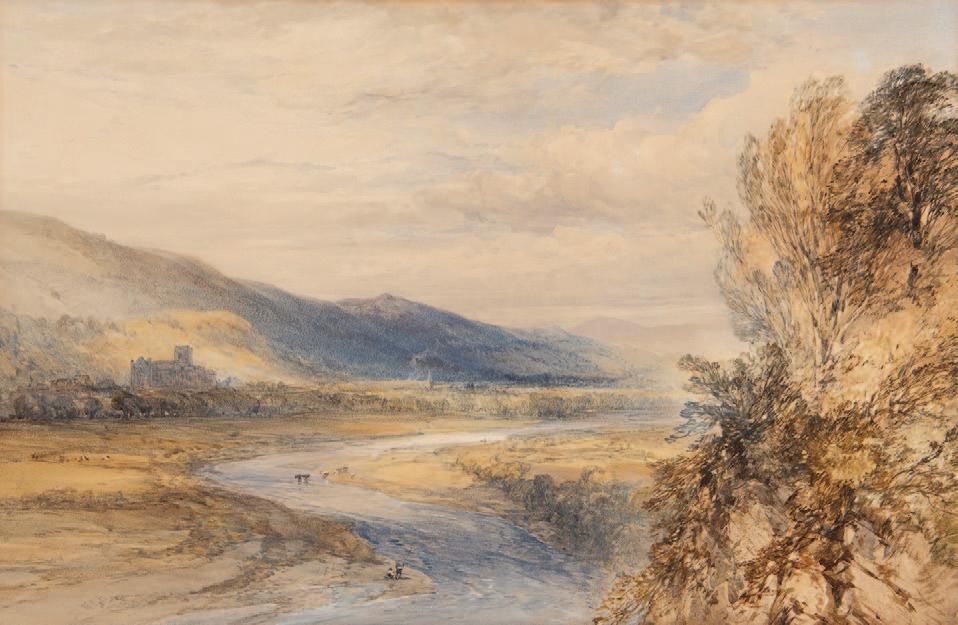
CAT. 29
Edwin Aaron Penley (1806-1870)
Melrose Abbey from the Banks of the River Tweed, Scotland
Signed lower right: Edwin A. Penley. 1873
Watercolour over pencil heightened with touches of bodycolour 17 ¾ by 14 ½ inches, 45.2 by 37 cm
Self-taught, Penley saw enormous value in the formal art education and spent much of his career teaching, as well as forging a career as a portraitist and painter in watercolours. He held several appointments as Drawing Master including
at Cheltenham College between 1846 and 1849, the East India Company College, Addiscombe and the Royal Military Academy Woolwich. He also reached out to a wider audience, writing several books on watercolour painting including

A System of Water-Colour Painting, 1850, The Elements of Perspective, 1851 and The English School of Painting in WaterColours in 1861. He was fascinated by innovation and new
forms of art and lectured on the process of photography, as well as being responsible for the introduction into Britain of several new colours including viridian and aureolin.
Melrose Abbey was founded by the Scottish King David I in 1136, as the first Cistercian monastery in Scotland, with the monks coming from Rievaulx Abbey in Yorkshire. Being sited on the often fought over border country between Scotland and England, it and the other similarly located religious houses, were easy targets for raids. See cat no. 28 for another view of Melrose Abbey.
CAT. 30
Signed lower right: by J. Ruskin/1861. Watercolour on buff paper 7 by 8 ½ inches, 18 by 21.6 cm
Provenance: Private Collection, UK
Ruskin drew constantly in order to help him understand both the natural and the architectural worlds. He believed that understanding was only fully achieved through close observation and that this process was helped by drawing what he saw. This belief was central to his teaching and Stephen Wildman has suggested that this drawing may be a teaching tool. Its lack of colour may mean that it was a demonstration in perspective and modelling. In the 1860s, Ruskin produced a number of carefully detailed studies of rocks, leaves, twigs, flowers, plants, feathers, animals and birds, in order to provide drawings as teaching aides, for his pupils to study and copy. During the 1870s he also made numerous studies of apples. There is a more highly coloured watercolour study of a single apple, which he produced working alongside his pupil, Louise Blandy in November 1875.
During the mid-1850s, Ruskin taught drawing at the Working
Men’s College, Campden, where he encouraged his pupils to study and record natural elements, such as leaves and twigs in order to train their eye and fully understand natural world.
It is likely that he also encouraged his students to draw from fruit, having taken inspiration from the work of William
Henry Hunt, who explored all types of fruit in his carefully worked and minutely detailed watercolours. Ruskin admired Hunt’s studies and especially his recording blemishes, imperfections and even bruises in his still lives.

CAT. 31
George Elgar Hicks
Study for Woman’s Mission –
Companion of Manhood c. 1862
Oil on Panel
10 ¾ by 8 ¾ inches, 27.25 by 22.25 cm Frame: English gold-leaf plaster frame; Second half 19th century
George Elgar Hicks was one of England’s best known painters of genre pictures, portraits and scenes of contemporary life in the Victorian period. He entered the Royal Academy Schools in 1844 and by 1848 he began a long and illustrious career exhibiting at the Academy and also at the British Institution and at the Society (later Royal Society) of British Artists in Suffolk Street Study for Woman’s Mission, is a fascinating re-emergence of a hitherto unknown sketch for one of Hicks’ celebrated pictures. His Woman’s Mission, exhibited in the Royal Academy in 1863 was a triptych of three 30 x 25 inch canvases, held in one frame. The central and right hand sections are now in the collection of Tate Britain. The left hand section is missing. This present picture is a highly finished study for the Tate’s central section.
This may be a study but it is remarkably finished and, as a picture, make perfect sense on its own as well. We see a man grief-stricken at the bad news he has received, which is
telegraphed to the viewer by the black edged letter and the fallen black-edged envelope. And we see his wife, care and compassion flowing through her expression and gesture, embodying the mid-victorian ideal of womanhood. This picture both in sketched and finished form is a delightful exercise in Hicks’s skills as a user of paint and composer of pictures. We are shown a typical middle-class parlour interior with all the furnishings and accoutrements an 1863 viewer would recognize. The manners of a couple of that period are similarly put before us – the laid breakfast table, the morning mail and of course the ominous black-edged letter. Much has been written about this triptych of paintings and today’s commentator must inevitably point to the restrictions of the Victorian woman’s life. But if we broaden our view and look with the eyes of an 1863 audience, this picture is an intriguing testament not only to the considerable expectation placed on the shoulders of a Victorian wife but also to what was justly celebrated about her as well

The Interior of the Artist’s Studio at West Preston Street, Edinburgh
Signed with the artist’s monogram u.r.: CH
Oil on panel, 11 ½ by 14 inches, 29 by 35.5 cm
Provenance: Edinburgh, Royal Scottish Academy, 1883, no.157
This depiction of Halkerston’s own studio in early 1880s Edinburgh is a satisfyingly unselfconscious portrayal of the workplace of a busy artist, replete with a stack of unfinished works in progress on the easel. The view through the window offers a glimpse of Edinburgh’s rooftops towards buildings that are now part of the city’s university. Halkerston was an
artist who enjoyed a notable reputation for his interior scenes, genre subjects and still lifes, many of which are influenced by the work of the Dutch Old Masters of the seventeenth century. He was a prolific exhibitor, showing some sixty three works at the Royal Scottish Academy from the mid nineteenth century until his death in 1899.
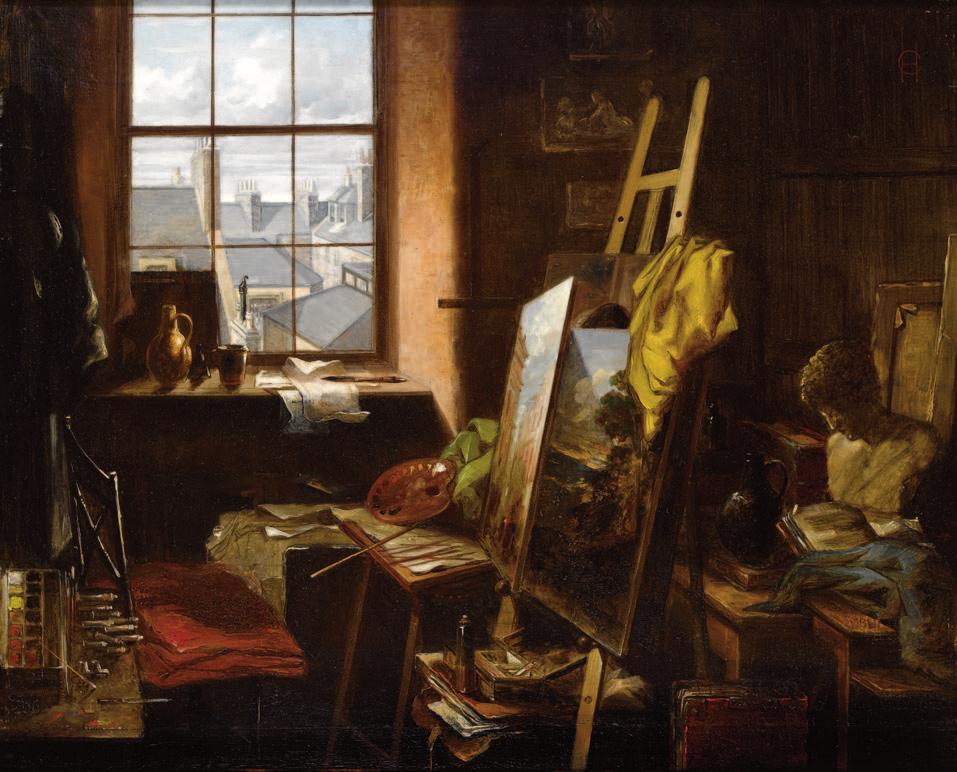
CAT. 33
Alfred F. Roffe (fl. c.1850-1889)
Loch Scene in Scotland
Oil on canvas
Signed: …F. Roffe and dated 18… 18 by 29 inches, 45.5 by 73.5cm
This remarkably well-executed Scottish landscape is the work of Alfred F. Roffe, who was working from about 1850 through until 1890. With his unusual surname he must have belonged to that quite numerous family of artists called Roffe, who emerged initially as successful engravers at the beginning of the 19th century.

Our present painting is a very precise example of highland landscape painting in the 19th century. Queen Victoria’s enthusiasm for the highlands had engendered a demand for depictions of Scotland of all sorts. From the 1840s onwards, inspired by the royal example and of course by the romanticism of Sir Walter Scott’s novels and the poetry of Robert Burns, artists were flocking to the highlands to paint the impressive scenery and as the century moved on pictures
of deer and highland cattle as well. By the 1870s - and for a good few decades after that - the prevailing style of brushstroking of such artists would have a looseness and quickness, almost a whiff of Impressionism, about it. This is also true of Roffe in his later work. But in this present picture there is a notable classicism of composition and a clarity and sharpness of detail in his execution. This must place our picture closer to 1850, so an early work for him. Roffe at this stage is still aiming effectively towards some element of the sublime, as trumpeted by the romantic movement in the first half of the century. And in this way his work here is redolent of the work of that very interesting earlier Scottish landscape painter John Knox (1778-1845).
CAT. 34
Frank O’Meara (Irish 1853-1888)
Girl by the River Loing

Oil on Canvas
Inscribed/Signed in the artist’s hand: A l’Ami Salis, Souvenir d’O’Meara 12 ¾ by 18 inches, 32.5 by 46 cm
Provenance: By Descent in a Private collection, Vienne, France This hitherto unknown sketch in oil is the work of that rare and still elusive Irish artist Frank O’Meara, who left his native Ireland in the 1870s to study in France. In this he was not unusual, like many young painters of varying nationalities. But in O’Meara’s case what was unusual was that he was effectively never to return to Ireland on any permanent basis. He studied in Paris from the mid-1870s onwards with initially sporadic trips to Grez-sur-Loing, the recently formed artist’s colony just to the south of Fontainebleau. By the early 1880s he had pretty much moved wholesale to Grez. And certainly from 1882 until 1887 he gave his address as Grez. One year later in 1888 he had died of malaria at the young age of 35.
O’Meara’s art is, like the art of so many of his contemporaries, a response to artistic developments in France. In Paris he would have seen at first hand the developing French Impressionists. But he also came under the sway of Jules Bastien-Lepage, the noted French Salon Naturalist, who favoured pictures with backgrounds of a semi-impressionist nature, but whose chosen figures, the French field-workers of his day, he depicted in a completely realistic and solid way.
O’Meara seems to have taken Bastien-Lepage as his starting point, but imbued this influence with his own sense of profound poetry and melancholy. In this he could be said to be responding to Bastien-Lepage and his circle in a perfectly Irish way.
Pictures by O’Meara are rare and the re-appearance of this exquisitely beautiful little oil sketch is much to be welcomed. It deals with many of the favourite O’Meara tropes. The low light, the single figure of the girl, the positioning of the subject by water and the peaceful, melancholy mood. In all probability it will relate to a lost finished picture by O’Meara. In Julian Campbell’s catalogue for the 1989 exhibition Frank O’Meara and his Contemporaries (Hugh Lane Gallery, Dublin) there is interestingly a quote from the Swedish artist and writer G.Pauli, who knew O’Meara at Grez. Recalling a picture by O’Meara he remembered it as: ‘A blond girl by the river; an evening atmosphere, with the moon high in the sky, and a belt of yellow reeds, a black scarf over her pink faded dress’. Looking at this present picture, there are differences but also obvious similarities. Our sitter is blond, she wears a faded pink dress, she has a black shawl draped (in this case) over the back of her chair. There is also the river, and the lighting may well be that of emerging moonlight early in a summer’s evening. If Pauli was not writing about this picture, it was clearly something related. The inscription on the picture – A l’Ami Salis - must refer to O’Meara’s French friend Rodolphe Salis, who had initially met O’Meara in Paris, where he too was training as a painter. The two art students would spend much time in each other’s company in Paris, but also in Grez until 1881. By then it had become clear that Salis’s talents lay elsewhere and he went on to find fame and fortune as the founder of the celebrated cabaret ‘Le Chat Noir’ in Paris in 1881. This picture, inscribed to Salis by O’Meara, was presumably given in memory of their days at Grez together.
But it should also be remembered that O’Meara was one of the very first non-French artists not only to come to Grez to paint, but to stay and make it his home. The Irishman was seen by many visiting artists as a firm fixture about the place and as such his influence on other painters cannot be underestimated. This hauntingly beautiful little sketch is quintessentially a Grez picture and if we look for O’Meara’s influence on other painters with pictures like this, we can note a pronounced similarity of tone and subject matter in the works of the gifted English artist William Stott. But the artist most directly influenced by O’Meara was his fellow Irishman John Lavery. Lavery’s Grez paintings are outstandingly poetic works and well-known. But it should not be forgotten that Lavery did not arrive in Grez until 1883, by which point O’Meara, with pictures such as this present sketch, had already


established his specific type of Grez picture. Once we accept that, when we look at Lavery’s A Woman and her Dog at Grez (1883), his A Grey Summer’s day at Grez (1883) or his celebrated Under the Cherry Tree (1884) – all of them gentle, moodinducing pictures with figures set against the backdrop of the Loing – we can definitely sense the genius loci of O’Meara setting the tone
It is thoroughly satisfying to add this enchanting little picture to the small body of O’Meara’s known work. The quiet, reflective beauty of the piece speaks for itself. But this picture also shows us not only how O’Meara absorbed the plein air lessons of his French contemporaries, but similarly how important his own work was in turn, in gently influencing so many significant artists who followed him to Grez, all those years ago.
We are grateful to Professor Kenneth McConkey for his help in compiling this entry.
CAT. 35
Self-Portrait
Signed with initials Red Chalks
8 by 7 inches, 20.3 by 17.8 cm, Oval
This assured head study in red chalk, recognizable by the distinctive initials, is the work of Thomas Riley, who was an English painter and etcher working from around 1878 to 1892. He exhibited at the Royal Academy and elsewhere in London, sending his pictures in from a Chelsea address. He is best remembered today from his etched work. Etched subjects cover some figure work, but concentrate mainly on landscape and architectural subjects, which were often used as illustrations to various publications. But he was clearly a painter as well and his pictures, known from their titles at the Royal Academy - Chloe, Jealousy, The Soul Released, and

Slumber - suggest that he was an artist also interested in the classical, allegorical and symbolist concerns of his day.
This picture, with its unmistakeable directness of connection between subject and viewer can only be a self-portrait. This is interesting as, up until now, no image of Thomas Riley has been known. Riley’s etchings are to be found, but his original drawings and paintings are rare. That we now have an image of Riley himself by his own hand makes a very welcome addition to the oeuvre of this interesting artist, who produced nothing beyond the early 1890s and, it must be concluded, died before his time
CAT. 36
Study of a Knight in Armour
Oil on Panel
11 by 10 inches, 27.9 by 25.4 cm
This attractive fluid study is a typical production from the late 19th century by one of those English artists clearly involved in the late phase of the Pre-Raphaelite movement. Inspiration for this type of subject inevitably leads back to Edward BurneJones. But more specifically our artist here shows himself to have been well aware of those later leaders of that movement
– J.W.Waterhouse, E.J Poynter and Frank Dicksee
The model however is well-known. The features are recognizeably those of the Italian Alessandro Di Marco. With his striking appearance, he appealed to, and was used by all those artists who were giving their pictures a setting in either the classical or the Renaissance world. Our artist has used Di Marco to give us a knight in armour, whose expression is shot through with typical late romantic yearning. In this the figure was probably intended to be a participant in one of those dream-like pictures, set in Arthurian times, which were so beloved of the Pre-Raphaelite painters.

CAT. 37
Frederic, Lord Leighton, P.R.A. (1830-1896)
Portrait of Alexandra Leighton, the Artist’s Sister, c.1853
With a landscape sketch (verso)
Bears inscription (under mount) Mrs Sutherland Orr/ an unpublished Portrait sketch/by her brother, Lord Leighton, PRA Charcoal heightened with white 8 inches, 20.5 cm (diameter)
Alexandra Leighton (later Mrs Sutherland Orr) was a sitter in a number of the artist’s works and a prominent expert on the English poet Robert Browning. The drawing bears some similarity to a striking portrait of Alexandra in profile and in Renaissance dress from c.1853 (now in the Crowther-Obak Collection of Victorian Art). Apparently unpublished in the artist’s lifetime, the present portrait was reproduced in The Weekly Magazine following Alexandra’s death in 1903.

CAT. 38
Edward Robert Hughes, R.W.S. (1851-1914)
Study of a Young Girl
Signed l l.: E.R.Hughes
Black and white chalk on brown paper 11 by 14 ¾ inches, 28 by 37.5 cm

Provenance: Christie's, London, 8 November 1996, lot 37
Hughes was studio assistant to the great Pre-Raphaelite painter William Holman Hunt and an increasingly invaluable figure as Hunt suffered from Glaecoma in the later part of his life. He consequently had a significant hand in several of his master’s great late works including The Light of the World and The Lady of Shalott. His own work is nevertheless extremely distinct and he developed his own style of late of late Pre Raphaelite painting and drawing which is frequently rich in both fantasy and symbolism. He was nephew of the painter Arthur Hughes, another key figure in the Pre Raphaelite movement
CAT. 39
Sir Edward Coley Burne-Jones Bt., A.R.A., R.W.S. (1833-1898)
Female Nude, a study for “The Golden Stairs”
Silverpoint and white chalk on grey prepared paper 11 by 8 ¼ inches, 28 by 21 cm
Provenance: from the artist to his granddaughter Angela Margaret Thirkell (née Angela Margaret Mackail); by descent to Graham Campbell McInnes (Graham Thirkell) then given to his son Simon McInnes in 1969
Exhibited: London, Burlington Fine Arts Club, Sir Edward Burne-Jones, Bart., 1899, no. 204.; National Gallery of Canada, Ottawa NGC (Musée des Beaux-Arts du Canada, Ottawa MBAC) on loan in 1980 (Jones L-2.3)
The present work forms part of a series of silverpoint drawings that are connected with Burne-Jones’s major Italianinspired painting The Golden Stairs (1876-1880) (Tate Gallery, London, acc.4005). The painting resulted from a trip to Italy in 1871 and coincides with a period sometimes referred to as the artist’s Florentine phase. The technique in this drawing was inspired by Florentine art of the Quattrocento, including the work of artists like Filippino Lippi. A number of related studies were given to the Ashmolean Museum as part of a bequest from Helen Mary Gaskell in 1939, see for example
Study for “The Golden Stairs” (The Visitors of the Ashmolean Museum, Oxford (acc.1939.15)). Like this drawing those works are notable for their grey prepared background which complements the greys and whites produced as a result of the application of the silverpoint medium and white chalk. This sensuous nude is a study for the prominent bending figure to the centre right of the finished painting. In common with other studies by Burne-Jones, the artist made the preliminary study as a life drawing prior to adding the fabric of the clothing.
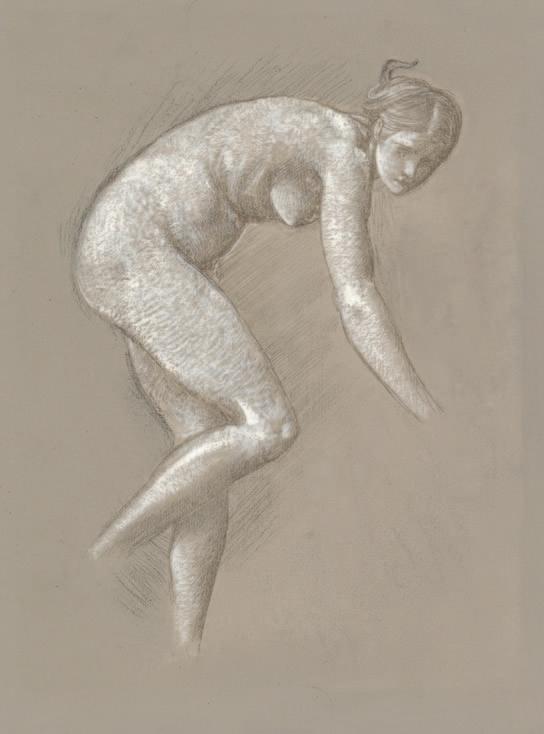
CAT. 40
Henry Holiday (1839-1927)
Beethoven Attending a Performance of his Ninth Symphony

Oil on paper, 9 by 19 ¼ inches, 32.5 by 49 cm
Holiday first attended a performance of Beethoven’s Ninth Symphony in 1859 and recalled in his autobiography that “After that, for years I never missed a performance of it, and by degrees assimilated it as I have hardly done any other work”
(Henry Holiday, Reminisences of My Life, Heinemann, London, 1914, p.63). Despite its central place in the Classical repertoire today, the symphony was hardly performed at the time and Holland later recalls how few of his contemporaries had ever heard it. Later in the same memoir, Holiday also recalls the touching moment recorded in the present work: “Beethoven sat near the conductor with his MS score on his knee, but heard nothing. He neither knew when it was finished, nor was
aware of the tumultuous applause which followed till Mademoiselle Sontag, the soprano, touched him on the arm and made him look round…” (ibid, p.63-64). A related pen and ink drawing of the same composition and subject was with the Maas Gallery in 1977 but the present oil sketch probably relates to an intended larger version of the subject in oil which he never completed. Music was a central part of Henry Holiday’s life both as a concert-goer, singer (performing for some time in the Bach and Richter Choruses in London) and even a composer, with several songs to his name.
We are grateful to Scott Thomas Buckle for his assistance.
CAT. 41
Arnold Wathen Robinson (1888-1955)
An Embracing Angel
Soft pencil, 26 ¾ by 16 ½ inches, 68 by 42 cm

Provenance: Campbell Wilson Fine Art
Robinson was a leading British stained glass artist and a prominent figure on the Bristol art scene in the early years of the twentieth century. He is closely associated with the stained glass firm Joseph Bell & Co, becoming first a director then owner of the business. His early work, in particular, is in the spirit of the late nineteenth century Arts and Crafts Movement and shows the influence of designers like William Morris and (particularly in the case of this impressive and fluid drawing) the work of Edward Burne-Jones. Much of Robinson’s commissioned work can be found in churches in the south and west of England, including what is arguably his masterpiece, a set of windows on the North Nave aisle of Bristol Cathedral depicting the Wartime work of the local civilian services.
CAT. 42
Edward Henry Fahey (1844-1907)
Looking out to Sea
Signed lower left: E.H. FAHEY. 74
Watercolour heightened with bodycolour 14 ½ by 10 ¼ inches, 36.7 by 26.3 cm

Provenance: With Martyn Gregory, July 2003; Private Collection until 2014
Edward Fahey was the son of the portrait and landscape artist James Fahey (1804-1885). He studied architecture before visiting Italy from 1866 to 1869. On his return, he entered the Royal Academy Schools to study painting. He exhibited at the Royal Academy and was a member of the Royal Institute of British Watercolourists from 1872.
CAT. 43
Walter Crane, R.W.S. (1845-1915)
Corfe Castle, Dorset
Signed with monogram and dated l l.: WC/89 and inscribed with dedication to the reverse of the original backboard Walter Crane to Richard Glazier in pleasant remembrance of cooperation at the Manchester School of Art
Watercolour, 10 ½ by 7 inches, 27 by 18 cm
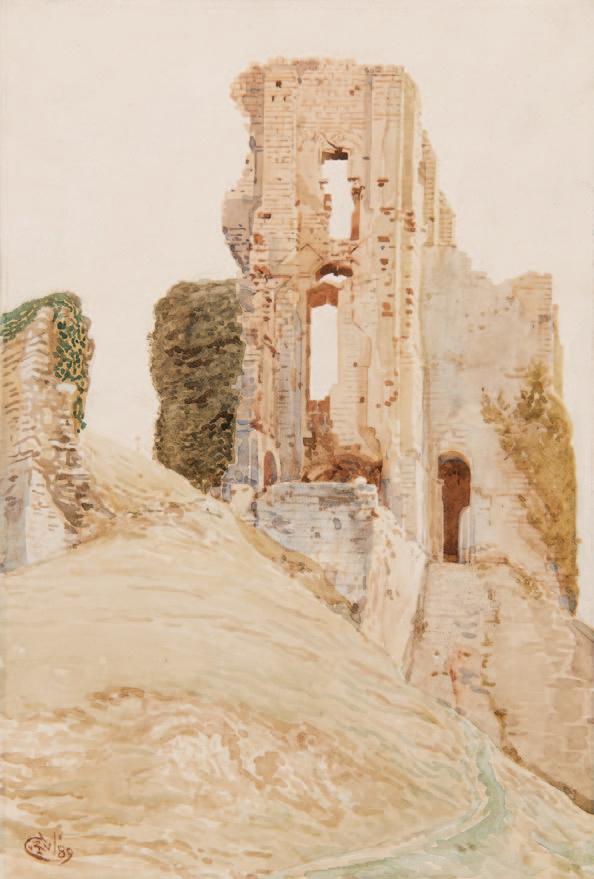
Provenance: a gift from the artist to Richard Glazier (1851-1918), Crane’s colleague and head master at Manchester School of Art
Crane was appointed Director of Design at Manchester School of Art in 1893. Glazier, to whom this watercolour was dedicated, was the school’s headmaster from its formation (following the amalgamation in 1892) until his sudden death in 1918. As well as a teacher and administrator, Glazier was an architect, well-known for his handbook A Manual of Historic Ornament
The following charming group of seven oil sketches come from the artist’s family and their descendants. Shannon, of IrishAmerican extraction, came from the U.S.A. to London in his late teens and rose to become one of England’s most successful portrait painters of the early 20th century. Shannon was always a figure painter and his early pictures in the 1880s were typically genre paintings, showing an awareness first of the social realist movement and later, around 1890, of the general move to painting en plein air. These pictures would be the kind of works he exhibited at the avant-garde New English Art Club, of which he was one of the founder members in 1886. But his popularity as a portrait painter grew to the point where, from around 1900, he would paint little else. His sitters’ book was always full and increasingly with appointments with the grandest in the land. Along the way he was elected an Associate of the Royal Academy (1897), a full member in 1909 and would be knighted in 1922.
Not all artists keep their sketches and it is fortunate this group of pictures has survived. These sketches give us an understanding of Shannon’s working methods. We note here too that practice, common in so many artists, of using his family members as models. And where the finished pictures are known it is interesting to compare the sketch to the final offering. But most of all we have an opportunity to feel the seemingly effortless dexterity Shannon showed in getting his first thoughts down on canvas. The fluency of the brush-working of this highly competent artist is compelling.
CAT. 44
A study for the portrait of Lady Marguerite Nevill, Lady Hastings

Oil on Canvas
Signed with initials; 28 by 16 inches, 71 by 40.6 cm
Note: The finished portrait now hangs in the Hastings family seat, Seaton Delaval Hall, Northumberland. Property of the National Trust
Oil on Canvas
27 by 20 inches, 68.6 by 50.8 cm
Note: A study of the artist’s wife and daughter


CAT. 47
Study of a Lady, leaning against a Tree
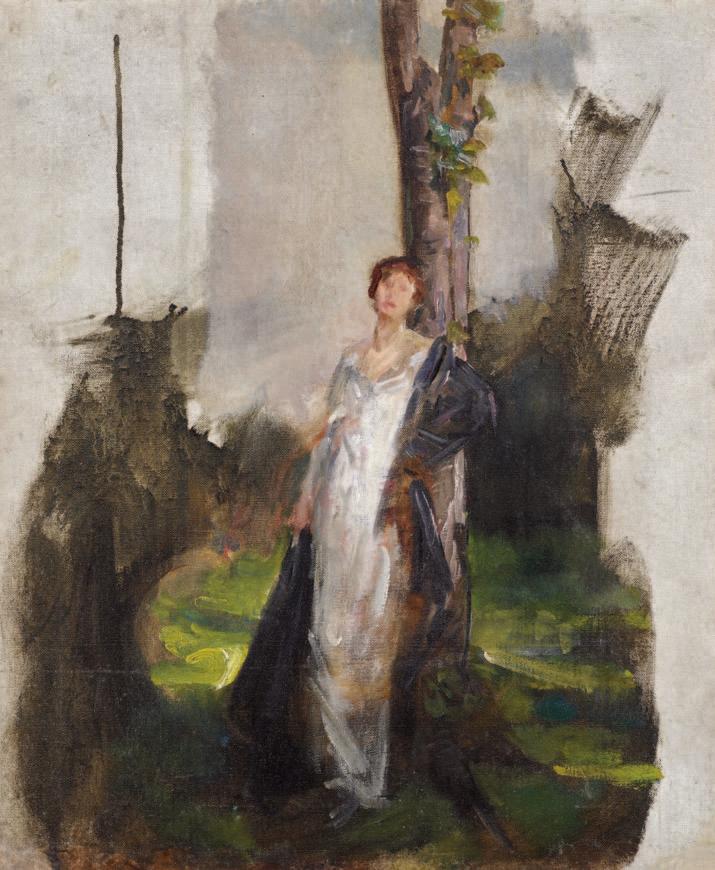
Oil on Canvas
24 by 20 inches, 61 by 50.8 cm
CAT. 48
Oil on Canvas
20 by 16 inches, 50.8 by 40.6 cm
Note: This is a study for the finished picture of the artist’s wife, dateable to 1915. This was in the artist’s family until its sale at Christie’s in 2016.

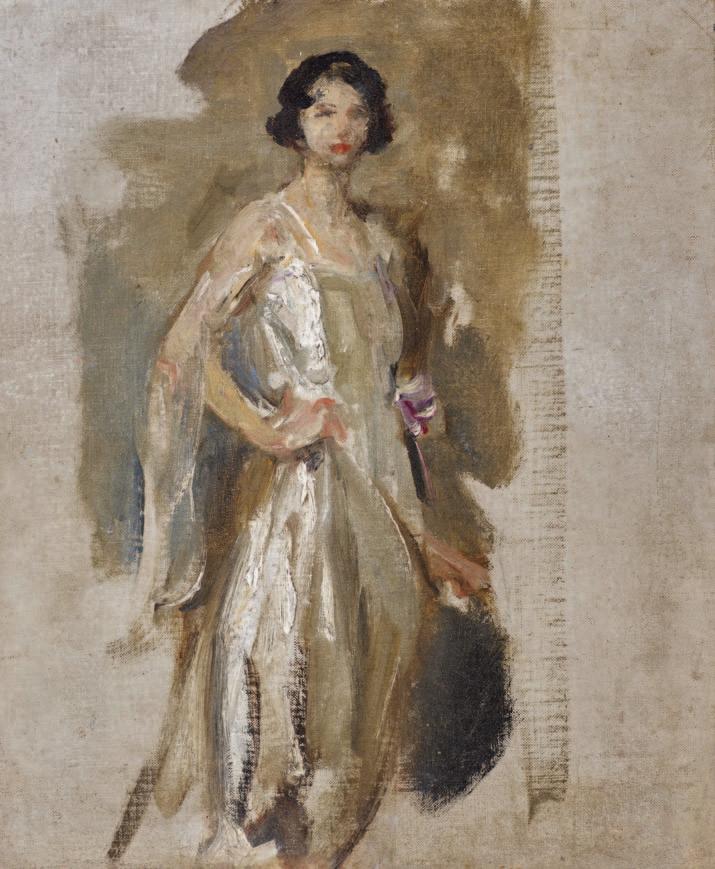
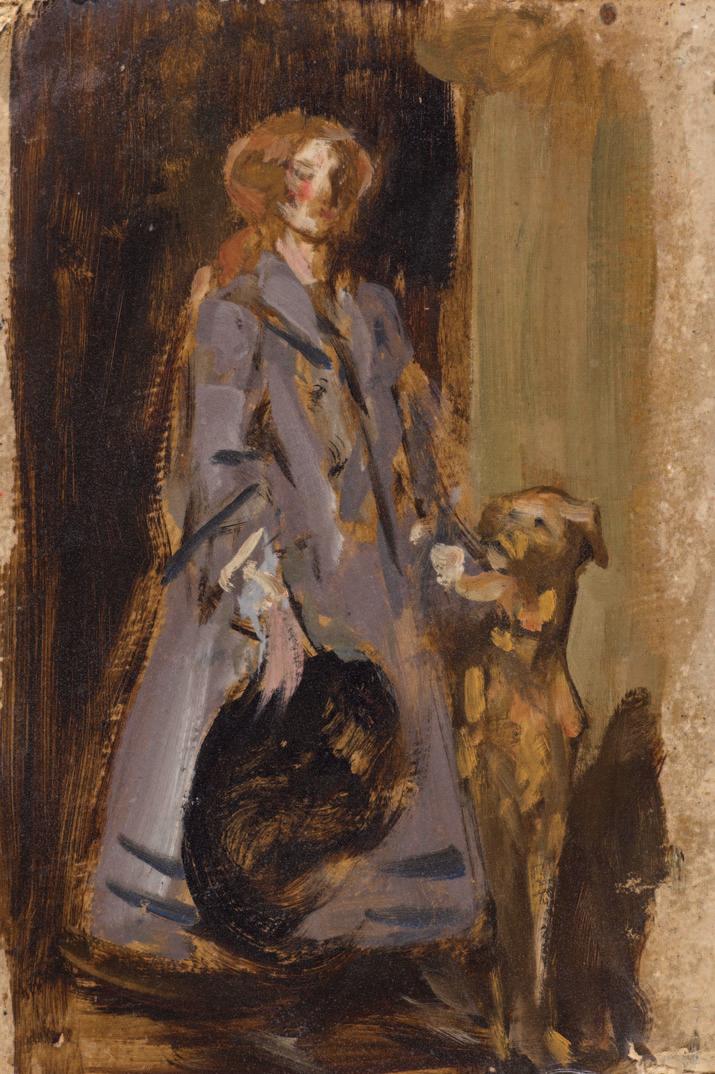
CAT. 51
Herbert Dalziel, R.O.I. (1858-1941)
Seascape, 1918

Signed and dated l l.: Herbert Dalziel/1918
Oil on canvas, 7 by 9 ¾ inches, 18 by 25 cm
In the catalogue for his landmark 1995 Barbican show Impressionism in Britain, Kenneth McKonkey wrote of Dalziel’s later work: “In an extraordinary departure, around 1910, Herbert Dalziel abandoned his conservative style and produced a number of jewel-like landscapes which adopt a sophisticated divisionism…the sense of atmosphere and weird luminosity draws comparisons with contemporary photography and the mystic landscapes of Khnopff.” Dalziel was the son of Thomas Dalziel, part of the important Victorian family wood-engraving business known as the Brothers Dalziel. He trained in Paris and in London and was an early member of the New English Art Club. His work, particularly his later paintings, are rare
CAT. 52
Edward Reginald Frampton, R.O.I. (1873-1923)
Signed l l.: E.Reginald Frampton
Tempera, 9 ¾ by 13 ¾ inches, 25 by 35 cm
Many of Frampton’s landscapes date from slightly later in his career and were painted when his literary, allegorical and figure subjects were beginning to go out of fashion. However, the Arts and Crafts influence that pervades those paintings remain in evidence in the landscape works which convey the same formal, decorative style as they do in the background to his larger figure pictures. Throughout is the influence of one of his artistic heroes, Edward Burne-Jones.
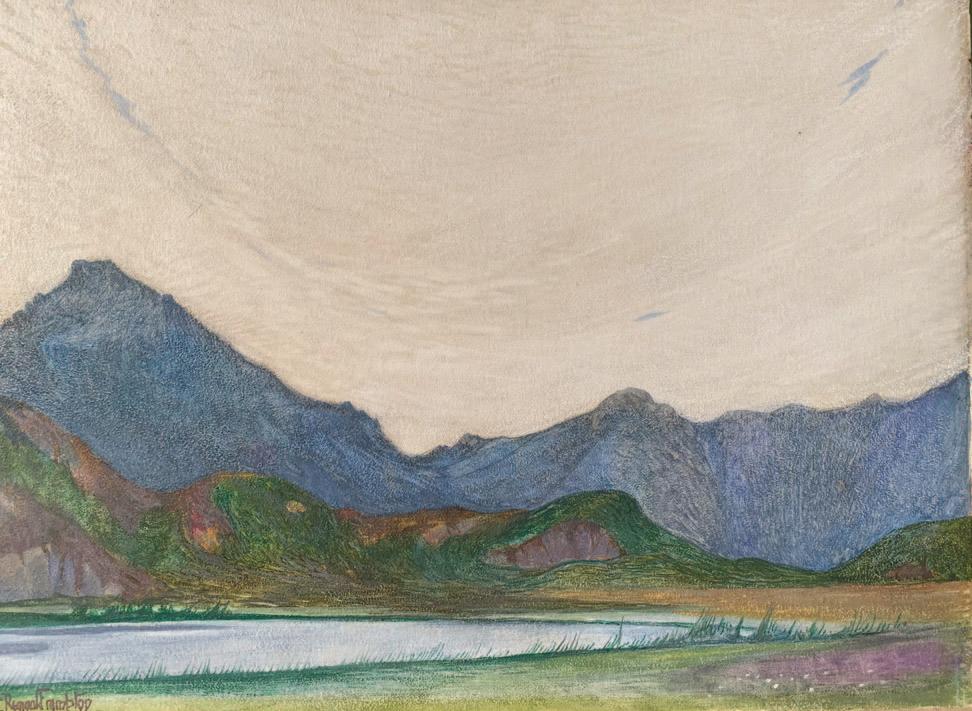
Mountain and Village by the Sea

Oil on canvas
15 ¾ by 23 ¼ inches, 40 by 59 cm
The illustrator W.T.Horton was one of the more eccentric and original artists working in the tradition of the English Aesthetic movement. He was a schoolmate of Aubrey Beardsley in Brighton (to whom he is regularly compared) and later studied architecture at the Royal Academy Schools in the 1880s. He abandoned this in favour of writing and drawing and became a mystic. He joined The Brotherhood of New Life where he came to know the Irish poet W.B.Yeats who was great champion of Horton’s work. His 1898 work A Book of Images, included an introduction written by Yeats himself. His work in oil is rare but identical in style to his better-known work as an illustrator in black and white. Like this painting those drawings are highly stylised, with sharp lines and contrasts in their method of execution, conjuring up a world that seems to spring directly from the pages of an Edwardian fairytale.
CAT. 54
Jessie Bayes (1876-1980)
Still Life in a Blue and White Vase

Signed l.r.: Jessie Bayes
Tempera on board
16 ½ by 13 ¼ inches, 42 by 33.5 cm
Bayes exhibited her first painting in tempera at the Royal Academy in 1935 – that work was also a floral still life. Jessie was from a talented artistic family that included her brothers, the Camden Town group painter Walter and the sculptor Gilbert Bayes. Their father was the painter Alfred Bayes. Jessie was a specialist in miniature painting, becoming a member of the Royal Society of Miniature Painters in 1906. She also executed some fine work in illuminated manuscript and stained glass. Her work was highly decorative in quality and strongly influenced by the Arts and Crafts Movement.
CAT. 55
Sir Frank Brangwyn, R.A., R.W.S. (1867-1956)
Train (Gare du Nord Paris), c.1920
Signed l.c.: Frank Brangwyn
Brush and Indian ink over pencil and red chalk 14 ½ by 21 ½ inches, 37 by 54.5 cm
This powerful drawing relates to a lithograph of the Gare du Nord executed by Brangwyn in c.1920. The print was published alongside two other views of the Gare du Nord in Frank Brangwyn, Zwanzig Graphische Arbeiten, published in 1921 by Wolf, Vienna. The book contained seventeen reproductions of drawings and original works on paper by the artist. Brangwyn was the pre-eminent Welsh artist of his generation and an accomplished muralist, printmaker and draughtsman. Perhaps his most famous work was the monumental mural scheme he painted for the South Corridor of the main lobby in 30 Rockefeller Plaza, New York in the mid 1930s. The paintings which chronicle man’s search for eternal truth were intended to compliment the murals by Jose Maria Sert in the north corridor of the same lobby.

CAT. 56
Walter Sickert, R.A. (1860-1942)
Musicians at the Gaîté Rochechouart
Signed l.r. Sickert and inscribed with title Gaîté Rouchechouard (sic) Black and white chalk over pen and ink on brown paper 8 by 11 ¼ inches, 20.5 by 28.5 cm

The Gaîté Rochechouart, a Parisian music hall in the Boulevard of the same name opened in 1867, eventually being destroyed by a fire in the early 1920s. The Music Hall attracted a number of important artists including Toulouse Lautrec and George Seurat, the latter of whom made an atmospheric drawing of a performance there in the late 1880s.
The present work is related to the painting Les Loges (see Wendy Baron, Sickert Paintings and Drawings, Yale, 2006, p.335, no.288), a picture that was a culmination of a series of on-the-spot studies of the theatre (like the present work) made by Sickert in around 1900. The final painting depicts the audience behind the same conductor, this lively study of one of the pit's violinists and singer suggesting a possible extension to that composition. In common with drawings he made of other theatrical venues he chose dark brown paper for his medium here, a factor that is central in conveying the gloominess of the musical hall’s interior and the essential seediness and edginess of some of the shows that were performed there.

With original faded certification label in the hand of the artist’s son Caspar (to reverse of original backboard)
Charcoal
24 by 18 inches, 61 by 45.5 cm
Provenance: acquired by the previous owner directly from the artist’s son, Caspar John
Rebecca John has suggested a date of circa 1897 for the present work, a period that coincides with John’s time studying at the Slade School of Art in London. John was widely considered to be the star pupil at the Slade in the 1890s at a time when the school was enjoying a golden period under the professorships of Henry Tonks and Fred Brown. In 1898 John won the Slade prize for his work Moses and the Serpent Life drawing was an essential part of Slade training although black life models were relatively rarely seen in any British art schools at this date. The impressive scale of this charcoal drawing marks it as one of John’s largest known works in this genre
CAT. 58
Noel Laura Nisbet, R.I. (1878-1961)
The Pipes of Pan
Watercolour 20 by 26 ½ inches, 50.8 by 67.3 cm Signed
Noel Nisbet was the daughter of the Scottish artist Hume Nisbet (1849-1923). One of two artistic daughters (her sister Margaret was also a painter) she studied at Clapham Art School, winning a number of medals for her work there. In 1910 she married fellow artist Harry Bush (1883-1957), with whom she had studied at Clapham. She set up house with him in the London suburb of Merton, where she lived all her adult life. But whereas her husband produced calm realistic pictures of the architecture and landscape he found around him, Noel was an artist of a very different kind. Her pictures are riots of the imagination, extemporizing on classical, allegorical and fairy-tale themes. Her figures, always anatomically correct, range from the genuinely strange to the very beautiful. These
she delivers in heightened colours, often favouring bright reds and oranges. Complementing her figures, her landscape settings are often rendered with a remarkable, almost enamellike concentration on detail. In all of the above respects she can be classified as one of that substantial body of artists who make up England’s ‘Late Pre-raphaelites’ and are sometimes termed ‘Last Romantics’. At her most fluent in watercolour rather than oil, she was also a well-known illustrator of children’s books – among them such titles as Cossack Fairy Tales and Folk Tales, The Polite Prince and Forty-Four Turkish Fairy Tales. She showed consistently at the Royal Academy and at the Royal Institute of Watercolour Painters, being elected a full member of the latter in 1926.

CAT. 59
Maurice Lambert, R.A. (1901-1964)
Parachutists, 1919
Signed and titled l l.: M. P. Lambert and dedicated and dated lower left to Penelope Spencer June 9th 1919 Watercolour over ink on paper, 21 ½ by 14 ½ ins, 55 by 37 cm
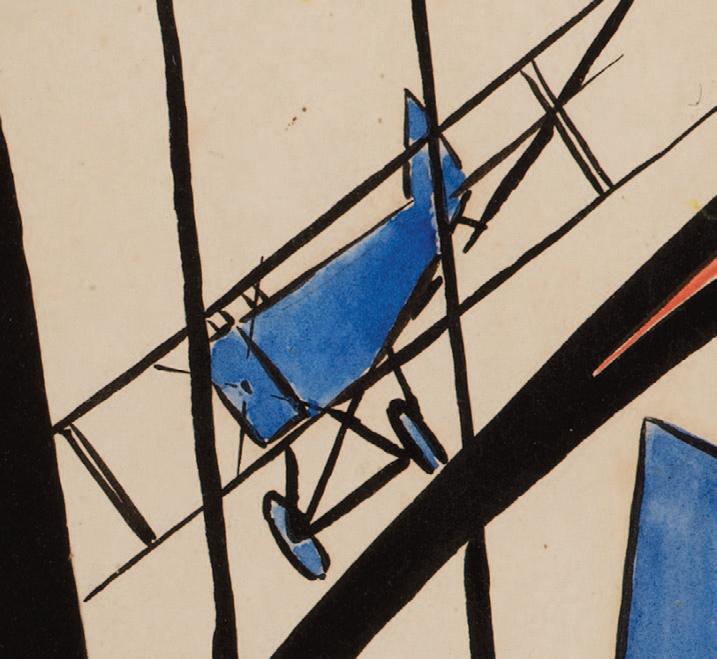
This powerful work was painted just at the end of the First World War when Lambert was working in the studio of the sculptor Francis D erwent Wood (1871-1926). Its visceral response to the War owes much to the Vorticist movement and the style of the Italian Futurists which had flourished in Europe in the previous few years and little to the restrained
Classicism of D erwent Wood. It does however anticipate Lambert’s own move towards modernism and his association in the 1930s with Barbara Hepworth, Henry Moore and the Seven and Five Society. The painting’s dedicatee, Penelope Spencer, was a leading ballerina of her era and friend of Lambert’s brother, the composer Constant Lambert

CAT. 60
Sir Stanley Spencer, R.A. (1891-1959)
Portrait of a Young Girl
Signed and dated l.r.: Stanley Spencer/July 1957
Pencil
19 ¼ by 10 ¾ inches, 49 by 27.5 cm
The sitter in this drawing is Clare George, the daughter of Joan George who was a great supporter of the artist later in his career and one of the founders of the Stanley Spencer Museum in Cookham in 1962. Joan first befriended Spencer following an article she wrote on the artist for the Yorkshire

Post She subsequently wrote a book on their friendship, Stanley Spencer Remembered. By the late 1950s Spencer was one of the most famous artists in England but he still found the
time to execute numerous fine portraits such as this, many depicting his friends and neighbours in his hometown of Cookham in Berkshire and often (it is said) responding to flurries of requests from fellow parishioners as he left church on Sunday. The artist’s unfinished portrait of Joan George from 1958 is in the collection of The Stanley Spencer Museum in Cookham.
CAT. 61
Duncan Grant

Signed with monogram and dated l.r.: DG/49 Red chalk
22 by 30 inches, 56 by 76 cm
Provenance: Paul Roche; direct from the previous owner to a private American collection Paul Roche was one of the most significant figures from the latter part of Duncan Grant’s life – a close friend, lover and companion, he travelled widely with him, later writing a book on Grant and dedicating significant energy towards furthering the artist’s reputation as the central artistic figure in the
Bloomsbury Group following his death in 1978. As one of Grant’s favourite muses and models, he also sat for the artist on numerous occasions from the late 1940s. This beautifully fluid, large scale nude study of Roche probably dates from circa 1950.
CAT. 62
Steven Spurrier, R.A., R.O.I. (1878-1961)
Portrait of a Girl in a Yellow Interior

Signed l l..: Spurrier
Oil on canvas, 24 by 20 inches, 61 by 51 cm
One of the most decorative British artists of his period, Spurrier juggled a successful career as both painter and illustrator and he exhibited some one hundred works at the Royal Academy between 1906 and 1961. He had a particular mastery in the graphic style of black and white illustration of the inter-war years and even wrote a book on the subject,
Black and White -A Manual of Illustration (1944). He was a prolific contributor to many leading publications from the date including The Graphic, Illustrated London News and Radio Times. In his work as a painter, as seen in this touching portrait of a young girl, a similarly graphic and decorative style is apparent in the medium of oil.
CAT. 63
Sir Cecil Beaton (1903-1980)
“Herald” for “Les Illuminations”, 1950
Signed l.r.: Beaton Watercolour over ink, 15 ½ by 10 ½ inches, 39.5 by 27 cm

Exhibited: Susan Sheehan Gallery, New York, Andy Warhol and Cecil Beaton - Design and Draughtsmanship, March-May 2000 (no.3)
The present work is an original design for Frederick Ashton’s ballet Illuminations, produced for New York City Ballet in 1950 with music by Benjamin Britten from his song cycle Les
Illuminations. John Piper wrote to Beaton describing as the latter’s designs for the ballet as “amongst the finest I have seen on the modern stage...”.
CAT. 64
Margaret Gere (1878-1965)
Farewells at Paddington Station
Signed and dated l l.: Margaret Gere/1948
Watercolour, bodycolour and pencil 16¾ by 13¾ inches, 43 by 35 cm
Provenance: The Fine Art Society, London; in The Fortunoff Collection [7931]
Exhibited: Cheltenham, Cheltenham Art Gallery & Museums, Margaret Gere Exhibition, 21 January -3 March 1984, cat no. D.4
Literature: Gaynor Andrew and George Breeze, Margaret Gere (1878-1965), Cheltenham Art Gallery exhibition catalogue, 1984 (illustrated as the front cover illustration for the catalogue)

Gere studied under her brother Charles March Gere at
Birmingham School of Art and much of her earlier work is influenced by him. Like her brother she was also a fine painter in tempera. She continued her studies at the Slade and was later a member of the New English Art Club and the Royal
Birmingham School of Art. This charming evocation of Paddington station has something of a stage-set quality, perhaps reflecting films of the later 1940s, in particular Brief Encounter that had been made a couple of years earlier.

CAT. 65
Gerald Leslie Brockhurst, R.A. (1890-1978)
Study of a Woman with an Earring

Signed lower right: G.L. Brockhurst Pencil
11 ¾ by 10 ½ inches, 30 by 27 cm
Gerald Leslie Brockhurst became one of the most celebrated and original portrait painters and printmakers of the interwar years. His portraits are characterised by their fine draughtsmanship and other-worldly qualities. Often set in idealised landscapes, the sitters appear to float in front of the picture plane. Although the field of portrait painting was oversubscribed at this time, by concentrating almost exclusively on female sitters and creating a bold and dynamic style, Brockhurst forged a position of pre-eminence and his sitters included the Duchess of Argyll and Duchess of Windsor, Merle Oberon and Marlene Dietrich..
He had entered Birmingham School of Art at the age of twelve and went on to the Royal Academy where he won many prizes including a travelling scholarship which in 1912 took him to Paris and Italy, where he studied the work of the fifteenth century masters. The influence of the Italian Renaissance, in particular the work of Piero della Francesca, Botticelli and Leonardo da Vinci, can often be seen in his portraits.
In 1939, at the height of his powers, he and his second wife moved to the United States of America, first to New York and then settling in Franklin Lakes, New Jersey. Brockhurst continued to paint portraits and to work as a printmaker. He became a U.S. citizen in 1949 and remained in the States for the rest of his life.
CAT. 66
Charles Cundall, R.A., R.W.S. (1890-1971)
HMS St Kitts with the Royal Escort on the Royal Trip to South Africa, 1947
Signed l.r.: Charles Cundall
Oil on canvas
24 by 20 inches, 61 by 51 cm
Exhibited: London, Royal Academy, 1947, no.346 Cundall painted this dramatic seascape in his capacity as official artist on the Royal trip to South Africa in 1947. This highly symbolic event was the first Royal trip to the Southern hemisphere since 1927 which significantly included not only George VI and Queen Elizabeth but also the future Queen then Princess Elizabeth who celebrated her twenty first birthday whilst in Africa. The family themselves travelled on HMS Vanguard, with the cruisers Cleopatra and Diadem and the destroyers St James and St Kitts (the present ship) acting
as escorts. Cundall, who had excelled as official War Artist for the Royal Navy during World War Two was the obvious choice as artist for the event. Two other works by Cundall from the trip (as well as the present painting) were exhibited at the Royal Academy Summer Exhibition in 1947: The Departure of the Royal Family to South Africa, 1st February, 1947 (no.340) and HMS Vanguard in the Bay (no.371). HMS St Kitts was a Battle-class destroyer which had first been launched in 1944.

CAT. 67
Ben Nicholson, O.M. (1894-1982)
Aegean, c.1967
Pencil, irregular sheet, mounted on prepared board, 15 by 11 inches, 38 by 28 cm (sheet only)
Provenance: the artist’s studio; Winifred Nicholson and thence by descent; with Caroline Wiseman
A sailing trip that Nicholson took in the Aegean Sea in May 1967 resulted in a series of drawings and a suite of etchings, Greek and Turkish Forms, all of which were inspired by that part of the world. In common with other work from the mid1960s, the prints in this set (to which the present drawing probably relates) examined Graeco-Roman architectural styles and motifs, with Nicholson lending his own abstract
interpretation to them. The etching set were jointly published by Ganymed Original Editions Ltd and Marlborough Fine Art Ltd and Nicholson himself donated a set to the Tate in 1968
(acc.2009).It has been suggested that this drawing may depict the temple of Aphaia in Aegina which Nicholson visited in his trip to the area.

CAT. 68
Dame Barbara Hepworth, D.B.E. (1903-1975)
Abstract – A Table Linen Design for Porthia Prints
Signed with initials l.r.: BH
Paper collage with watercolour 12 ¼ by 17 ¾ inches, 31.5 by 45.5 cm
Literature: Geoffrey Rayner et al., Textile Design: Artists' Textiles 1940-1976, Antique Collectors' Club Ltd., 2014, p.93 for an example of the table linen in the grey colour

Porthia Prints, formed in the 1950s by the sculptor D enis Mitchell and his brother, was set up to promote the St Ives art scene in Cornwall commercially and the venture produced a series of table mats that were sold by Heal & Son in London. The present work is Hepworth’s original design for the project and a rare example of her work in collage. Despite an impressive line-up of artists, including Hepworth, Patrick
Heron, Peter Lanyon and William Gear, the project eventually suffered from supply issues and folded. The resulting linens are now very rare. The present design provided inspiration for a garden installation at the front of Tate Britain that coincided with the 2015 exhibition Barbara Hepworth: Sculpture for a Modern World, the simplicity and bold lines of this design particularly appealing to its curators.
CAT. 69
Graham Sutherland, O.M. (1903-1980)

Thorn Stucture, 1971
Signed with initials and dated l.r.: GS/71
Watercolour with bodycolour over ink and pencil
14 ½ by 10 ¼ inches, 37 by 26 cm
Provenance: Jason and Rhodes Gallery; Goldmark Gallery
Sutherland’s enduring fasctination with the motif of thorns developed soon after the end of World War Two when he was commissioned to make a major Crucifixion painting for St Matthew’s Church, Northampton in the English midlands. It was a motif he re-worked in a number of compositions and in a variety and contrasting range of colours. The present
work most closely relates to the 1971 lithograph Three Thorn Trees (Tassi 128) and appears to be working of the form to the left hand side of this print. Sutherland later observed that thorns acted ‘like dividers pricking out points in space in all directions, encompassing the air, as if it were solid and tangible.’
CAT. 70
Sir Terry Frost, R.A. (1915-2003)
Mobile
Cut-out mobile with collage in various sections
30 ¾ inches, 78 cm (approx length)
Inscribed and dated l.c.: A Happy Birthday Denis/Terry/77
Provenance: a birthday present from the artist to the sculptor Denis Mitchell
The present work originally came from the estate of the sculptor Denis Mitchell (1912-1993). Mitchell was a key figure in the St Ives group of artists and for many years studio assistant to Barbara Hepworth. He was a close friend of Frost who gave Mitchell a number quirky pieces such as this as birthday and Christmas presents. Frost regularly experimented
with the form of the mobile, including the creating of a design made in collaboration with the Danish firm Flensted made to be sold in the shop at the Tate Gallery in London. This interest was partly driven by his admiration for the American artist Alexander Calder.

Alken, Henry Thomas (1785 – 1851)
Bayes, Jessie (1876-1980)
Beaton, Sir Cecil (1903-1980)
Beechey, Sir William (1753–1839) 18
Boys, Thomas Shotter (1803-1874)
Brangwyn, Sir Frank, R.A., R.W.S. (1867-1956)
Bright, Henry (1810-1873) 22
Brockhurst, Gerald Leslie, R.A (1890-1978)
Burne-Jones, Sir Edward Coley Bt.,
A.R.A., R.W.S (1833-1898) 50
Callow, William, R.W.S. (1812-1908) 36
Cox, David (1783-1859) 25
Crane, Walter, R.W.S. (1845-1915)
Cundall, Charles, R.A., R.W.S. (1890-1971)
Dalziel, Herbert, R.O.I. (1858-1941)
Dance, Nathaniel R.A. (1735 -1811) 3
Downman, John, A.R.A. (1750-1824) 10
Edridge, Henry (1768-1821)
English School, Circa 1890
Fahey, Edward Henry (1844-1907)
Frampton, Edward Reginald, R.O.I. (1873-1923)
Frost, Sir Terry, R.A. (1915-2003) 83
Gere, Margaret (1878-1965) 76
Grant, Duncan (1885-1978) 73
Halkerston, Charles (1840-1899) 42
Hayter, John (1800-1891)
Hayter, Sir George (1792-1871)
Hepworth, Dame Barbara, D.B.E. (1903-1975)
Hicks, George Elgar (1824 – 1914)
Hills, Robert (1769-1844)
Holiday, Henry (1839-1927)
Horton, William Thomas (1864-1919) 64
Hughes, Edward Robert, R.W.S. (1851-1914)
John, Augustus, O.M., R.A. (1878-1961)
Kettle, Tilly (1735 -1786) 2
Lambert, Maurice, R.A. (1901-1964) 70
Lawrence, Sir Thomas, P.R.A. (1769-1830)
Leighton, Lord Frederic, P.R.A. (1830-1896) 48
Nicholl, Andrew, R.H.A. (1804-1886) 32, 33
Nicholson, Ben, O.M. (1894-1982) 80
Nisbet, Noel Laura R.I. (1887 – 1956) 69
Nixon, John (1755-1818) 13
58 East 79 Street, New York, New York 10075, USA
Tel: 212-861-4050
Fax: 212-772-1314
shepherdNY@aol.com
www.shepherdgallery.com
BAGSHAWE FINE ART
Nicholas Bagshawe
Dr Kendall Bagshawe
By appointment
Belgravia,
London SW1W 8PD
Tel: +44 (0)207 097 3106
info@bagshawes.com
www.bagshawes.com
O’Meara, Frank (1853-1888) 44
Penley, Edwin Aaron (1806-1870) 37
Prout, Samuel (1783-1852) 21
Read, Catherine (1723-1777) 4
Richardson Senior, Thomas Miles
(1784-1848) 27
Richmond, George, R.A. (1809-1896) 34
Riley, Thomas (1856 - circa 1892) 46
Robinson, Arnold Wathen (1888-1955) 52
Roffe, Alfred F. (Fl. c1850 – 1889) 43
Romney, George (1734-1802) 14
Rowlandson, Thomas (1756-1827) 12
Ruskin, John (1819-1900) 38
Russell, John, R.A. (1745-1806) 8
Shannon, Sir James Jebusa
R.A. (1862-1923) 55, 56, 57, 58, 59, 60, 61
Sickert, Walter, R.A. (1860-1942) 67
Smith, John ‘Warwick’ (1749-1831) 17
Spencer, Sir Stanley, R.A. (1891-1959) 72
Spurrier, Steven, R.A., R.O.I. (1878-1961) 74
Sutherland, Graham, O.M. (1903-1980) 82
Varley, John (1778-1842) 24
Ward, James, R.A. (1769-1859) 16
Wyld, William (1806-1889) 35
GUY PEPPIATT FINE ART
Guy Peppiatt
Riverwide House, 6 Mason’s Yard, Duke Street, St James’s
London SW1Y 6BU, United Kingdom
Tel: +44 (0) 20 7930 3839
guy@peppiattfineart.co.uk
www.peppiattfineart.co.uk
MOORE-GWYN FINE ART
Harry Moore-Gwyn
6 Mason’s Yard, Duke Street, St James’s, London SW1Y 6BU, United Kingdom
Tel: +44 (0) 7765 966256
harry@mooregwynfineart.co.uk
www.mooregwynfineart.co.uk
Credits:
Design: Sarah Garwood Creative, sarahagarwood@outlook.com
Print: Zenith Print Group, enquiries@zenithprintgroup.com
Inside back cover:
Edward Robert Hughes, R.W.S. (1851-1914)
Study of a Young Girl [Cat. 38]

